Spring 2017
Editor’s Note
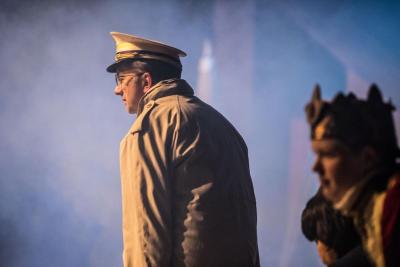 “Oh, what sad times are these when passing ruffians can say ‘Ni’ at will to old ladies,” said Ian Bates ’19, a.k.a. Roger the Shrubber, in last fall’s production of Marlboro College and the Holy Grail (see Events). “There is a pestilence upon this land; nothing is sacred. Even those who arrange and design shrubberies are under considerable economic stress at this point in time.”
“Oh, what sad times are these when passing ruffians can say ‘Ni’ at will to old ladies,” said Ian Bates ’19, a.k.a. Roger the Shrubber, in last fall’s production of Marlboro College and the Holy Grail (see Events). “There is a pestilence upon this land; nothing is sacred. Even those who arrange and design shrubberies are under considerable economic stress at this point in time.”
Times are indeed dark and divisive, and one would be excused for perceiving a certain melancholy in this issue of Potash Hill, from Sophie Gorjance’s peek into dystopian linguistics to Marcus DeSieno’s disconcertingly stark and beautiful landscapes. Morgan Ingalls’ account of researching nocturnal, cave-loving, snaggletooth mammals threatened by a mysterious plague could be construed as positively gothic in its darkness, but there is another side to these stories, of course.
Ralph Waldo Emerson said, “When it is dark enough, you can see the stars.” It often takes a step into the unfamiliar to make new discoveries, gain new perspectives, touch the ineffable. That’s true whether the path leads to post-apocalyptic fiction, surveillance technology, or dank, claustrophobic caves. Or long, snowy winters at a tiny college on a hill, for that matter.
In this period of uncertainty, nationally and around the world, I am grateful to be part of a strong campus community that strives for honest, creative inquiry, one that is open to diverse thoughts, races, religions, and backgrounds. In recent months Marlboro College has redoubled its commitment to diversity and inclusion, including a new task force on making the college a safe and welcoming place for international students. Like other community members, I value the college’s founding principles of democracy and its practices that promote citizen engagement and global perspective.
I welcome your diverse thoughts on this issue of Potash Hill, or on the place of Marlboro College in an uncertain world. What did you discover at Marlboro, and where did that lead you? Share your perspective with us at pjohansson@marlboro.edu.
—Philip Johansson
a.k.a. Boat-keeper at the Castle Aargh (see photo)
Inside Front cover
Potash Hill
Published twice every year, Potash Hill shares highlights of what Marlboro College community members, in both undergraduate and graduate programs, are doing, creating, and thinking. The publication is named after the hill in Marlboro, Vermont, where the undergraduate campus was founded in 1946. “Potash,” or potassium carbonate, was a locally important industry in the 18th and 19th centuries, obtained by leaching wood ash and evaporating the result in large iron pots. Students and faculty at Marlboro no longer make potash, but they are very industrious in their own way, as this publication amply demonstrates.
Editor: Philip Johansson
Photo Editor: Ella McIntosh
Staff Photographers: David Teter ’19 and Michael Jung ’17
Design: New Ground Creative
Potash Hill welcomes letters to the editor. Mail them to: Editor, Potash Hill, Marlboro College, P.O. Box A, Marlboro, VT 05344, or send email to pjohansson@marlboro.edu. The editor reserves the right to edit for length letters that appear in Potash Hill.
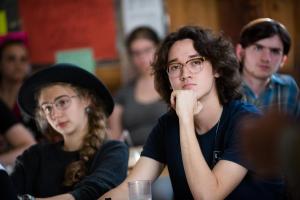 Front Cover: A caver pauses on the brink of a recently discovered Vermont cave, perhaps the winter home of federally threatened long-eared bats or other bat species. Morgan Ingalls has been spelunking her way across New England to get to know these cryptic species better (see her article). Photo by John Dunham
Front Cover: A caver pauses on the brink of a recently discovered Vermont cave, perhaps the winter home of federally threatened long-eared bats or other bat species. Morgan Ingalls has been spelunking her way across New England to get to know these cryptic species better (see her article). Photo by John Dunham
“I think this college has been a perfect fit for the kind of education I’ve been wanting to pursue,” said freshman Eric Wefeld (pictured, right) at a Town Meeting last November. His comments on gratitude were part of a series of “First Year Voices,” reflections by new students on life at Marlboro. See Eric.
About Marlboro College
Marlboro College provides independent thinkers with exceptional opportunities to broaden their intellectual horizons, benefit from a small and close-knit learning community, establish a strong foundation for personal and career fulfillment, and make a positive difference in the world. At our campus in the town of Marlboro, Vermont, both undergraduate and graduate students engage in deep exploration of their interests—and discover new avenues for using their skills to improve their lives and benefit others—in an atmosphere that emphasizes critical and creative thinking, independence, an egalitarian spirit, and community.
Up Front
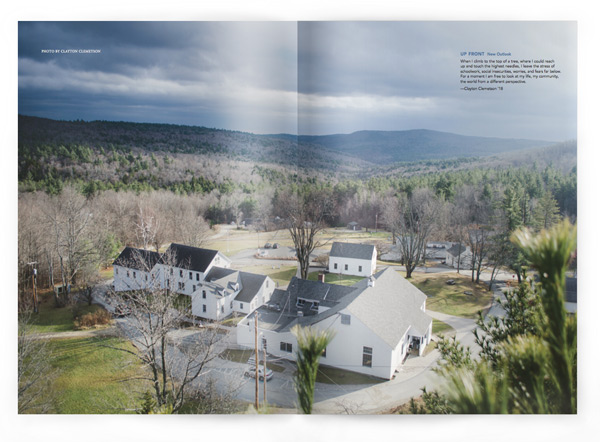
New Outlook
When I climb to the top of a tree, where I could reach up and touch the highest needles, I leave the stress of schoolwork, social insecurities, worries, and fears far below. For a moment I am free to look at my life, my community, the world from a different perspective.
—Clayton Clemetson ’18
Photo by Clayton Clemetson
Clear Writing
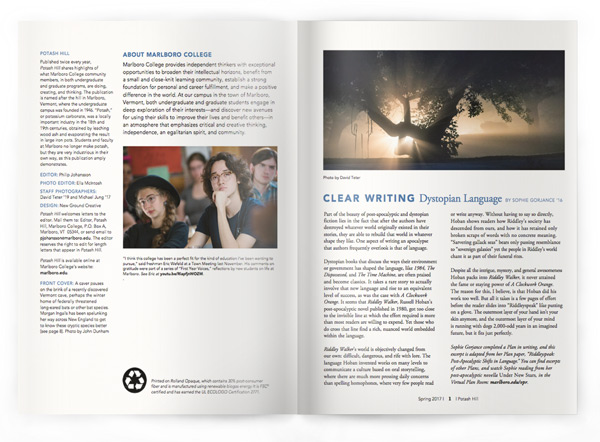
Dystopian Language
By Sophie Gorjance ’16
Part of the beauty of post-apocalyptic and dystopian fiction lies in the fact that after the authors have destroyed whatever world originally existed in their stories, they are able to rebuild that world in whatever shape they like. One aspect of writing an apocalypse that authors frequently overlook is that of language.
Dystopian books that discuss the ways their environment or government has shaped the language, like 1984, The Dispossessed, and The Time Machine, are often praised and become classics. It takes a rare story to actually involve that new language and rise to an equivalent level of success, as was the case with A Clockwork Orange. It seems that Riddley Walker, Russell Hoban’s post-apocalyptic novel published in 1980, got too close to the invisible line at which the effort required is more than most readers are willing to expend. Yet those who do cross that line find a rich, nuanced world embedded within the language.
Riddley Walker’s world is objectively changed from our own: difficult, dangerous, and rife with lore. The language Hoban invented works on many levels to communicate a culture based on oral storytelling, where there are much more pressing daily concerns than spelling homophones, where very few people read or write anyway. Without having to say so directly, Hoban shows readers how Riddley’s society has descended from ours, and how it has retained only broken scraps of words with no concrete meaning. “Sarvering gallack seas” bears only passing resemblance to “sovereign galaxies” yet the people in Riddley’s world chant it as part of their funeral rites.
Despite all the intrigue, mystery, and general awesomeness Hoban packs into Riddley Walker, it never attained the fame or staying power of A Clockwork Orange. The reason for this, I believe, is that Hoban did his work too well. But all it takes is a few pages of effort before the reader slides into “Riddleyspeak” like putting on a glove. The outermost layer of your hand isn’t your skin anymore, and the outermost layer of your mind is running with dogs 2,000-odd years in an imagined future, but it fits just perfectly.
Sophie Gorjance completed a Plan in writing, and this excerpt is adapted from her Plan paper, “Riddleyspeak: Post-Apocalyptic Shifts in Language.” You can find excerpts of other Plans, and watch Sophie reading from her post-apocalyptic novella Under New Stars, in the Virtual Plan Room.
Photo by David Teter
Letters
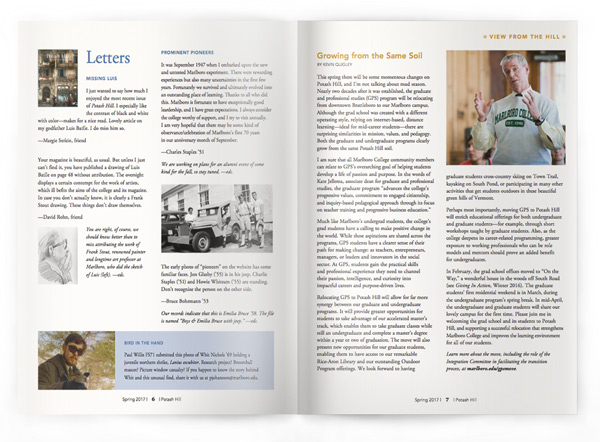
Missing Luis 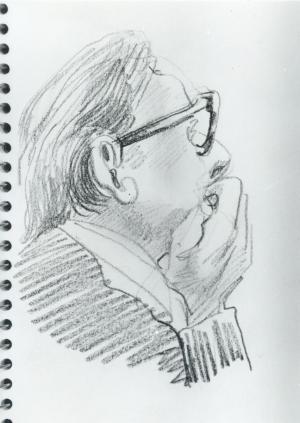 I just wanted to say how much I enjoyed the most recent issue of Potash Hill. I especially like the contrast of black and white with color—makes for a nice read. Lovely article on my godfather Luis Batlle. I do miss him so.
I just wanted to say how much I enjoyed the most recent issue of Potash Hill. I especially like the contrast of black and white with color—makes for a nice read. Lovely article on my godfather Luis Batlle. I do miss him so.
—Margie Serkin, friend
Your magazine is beautiful, as usual. But unless I just can’t find it, you have published a drawing of Luis Batlle on page 48 without attribution. The oversight displays a certain contempt for the work of artists, which ill befits the aims of the college and its magazine. In case you don’t actually know, it is clearly a Frank Stout drawing. These things don’t draw themselves.
—David Rohn, friend
You are right, of course, we should know better than to miss attributing the work of Frank Stout, renowned painter and longtime art professor at Marlboro, who did the sketch of Luis (right). —eds.
Prominent Pioneers
It was September 1947 when I embarked upon the new and untested Marlboro experiment. There were rewarding experiences but also many uncertainties in the first few years. Fortunately we survived and ultimately evolved into an outstanding place of learning. Thanks to all who did this. Marlboro is fortunate to have exceptionally good leadership, and I have great expectations. I always consider the college worthy of support, and I try to visit annually. I am very hopeful that there may be some kind of observance/celebration of Marlboro’s first 70 years in our anniversary month of September.
—Charles Staples ’51
We are working on plans for an alumni event of some kind for the fall, so stay tuned. —eds.
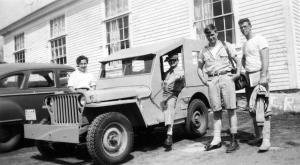 The early photo of “pioneers” on the website (right) has some familiar faces. Jon Glasby (’55) is in his jeep, Charlie Staples (’51) and Howie Whittum (’55) are standing. Don’t recognize the person on the other side.
The early photo of “pioneers” on the website (right) has some familiar faces. Jon Glasby (’55) is in his jeep, Charlie Staples (’51) and Howie Whittum (’55) are standing. Don’t recognize the person on the other side.
—Bruce Bohrmann ’53
Our records indicate that this is Emilia Bruce ’58. The file is named “Boys & Emilia Bruce with jeep.” —eds.
Bird in the Hand 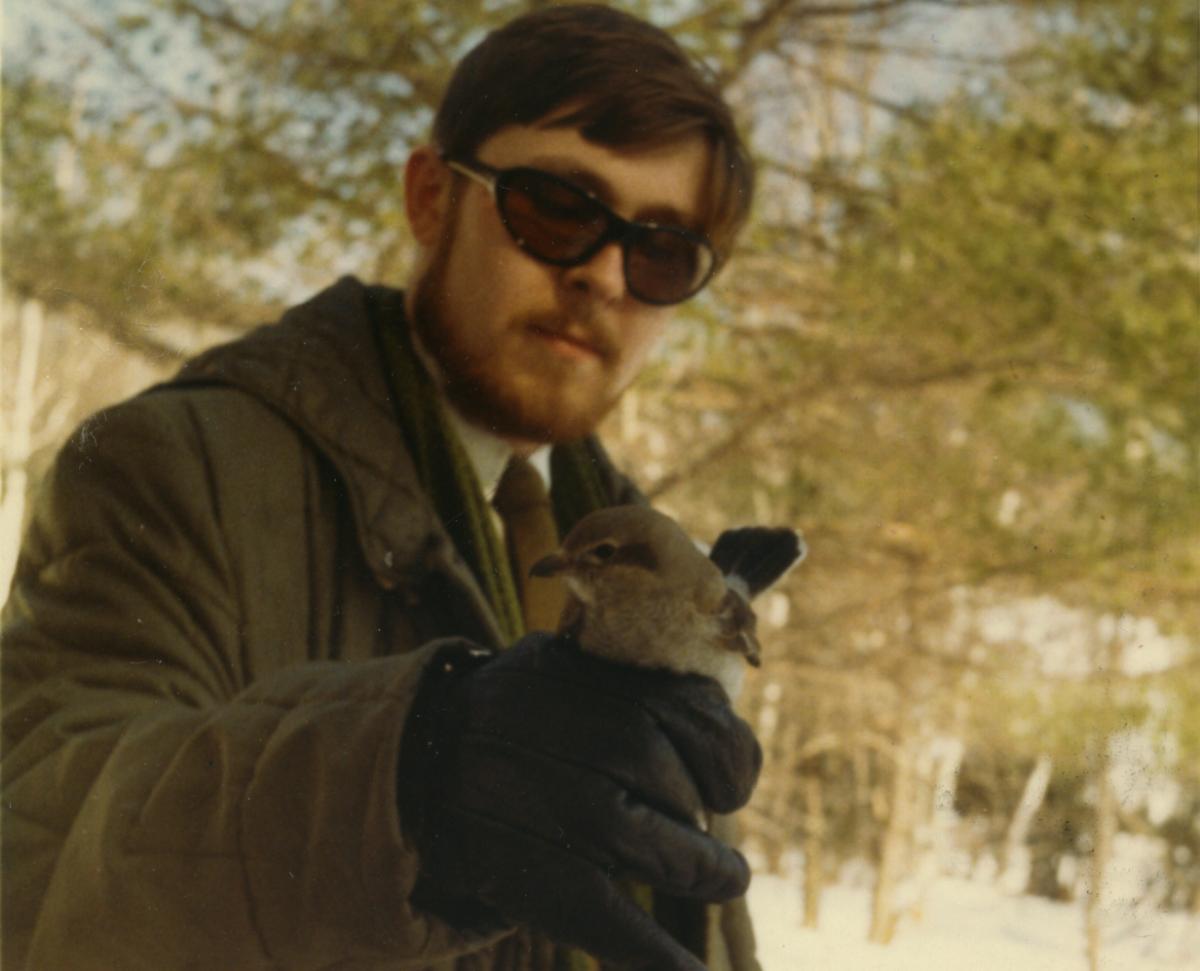 Paul Willis FS71 submitted this photo (right) of Whit Nichols ’69 holding a juvenile northern shrike, Lanius excubitor. Research project? Broomball mascot? Picture window casualty? If you happen to know the story behind Whit and this unusual find, share it with us at pjohansson@marlboro.edu.
Paul Willis FS71 submitted this photo (right) of Whit Nichols ’69 holding a juvenile northern shrike, Lanius excubitor. Research project? Broomball mascot? Picture window casualty? If you happen to know the story behind Whit and this unusual find, share it with us at pjohansson@marlboro.edu.
View from the Hill
Growing from the Same Soil
By Kevin Quigley
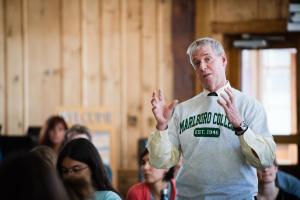 This spring there will be some momentous changes on Potash Hill, and I’m not talking about mud season. Nearly two decades after it was established, the graduate and professional studies (GPS) program will be relocating from downtown Brattleboro to our Marlboro campus. Although the grad school was created with a different operating style, relying on internet-based, distance learning—ideal for mid-career students—there are surprising similarities in mission, values, and pedagogy. Both the graduate and undergraduate programs clearly grow from the same Potash Hill soil.
This spring there will be some momentous changes on Potash Hill, and I’m not talking about mud season. Nearly two decades after it was established, the graduate and professional studies (GPS) program will be relocating from downtown Brattleboro to our Marlboro campus. Although the grad school was created with a different operating style, relying on internet-based, distance learning—ideal for mid-career students—there are surprising similarities in mission, values, and pedagogy. Both the graduate and undergraduate programs clearly grow from the same Potash Hill soil.
I am sure that all Marlboro College community members can relate to GPS’s overarching goal of helping students develop a life of passion and purpose. In the words of Kate Jellema, associate dean for graduate and professional studies, the graduate program “advances the college’s progressive values, commitment to engaged citizenship, and inquiry-based pedagogical approach through its focus on teacher training and progressive business education.”
Much like Marlboro’s undergrad students, the college’s grad students have a calling to make positive change in the world. While these aspirations are shared across the programs, GPS students have a clearer sense of their path for making change: as teachers, entrepreneurs, managers, or leaders and innovators in the social sector. At GPS, students gain the practical skills and professional experience they need to channel their passion, intelligence, and curiosity into impactful careers and purpose-driven lives.
Relocating GPS to Potash Hill will allow for far more synergy between our graduate and undergraduate programs. It will provide greater opportunities for students to take advantage of our accelerated master’s track, which enables them to take graduate classes while still an undergraduate and complete a master’s degree within a year or two of graduation. The move will also present new opportunities for our graduate students, enabling them to have access to our remarkable Rice-Aron Library and our outstanding Outdoor Program offerings. We look forward to having graduate students cross-country skiing on Town Trail, kayaking on South Pond, or participating in many other activities that get students outdoors in these beautiful green hills of Vermont.
Perhaps most importantly, moving GPS to Potash Hill will enrich educational offerings for both undergraduate and graduate students—for example, through short workshops taught by graduate students. Also, as the college deepens its career-related programming, greater exposure to working professionals who can be role models and mentors should prove an added benefit for undergraduates.
In February, the grad school offices moved to “On the Way,” a wonderful house in the woods off South Road (see Giving In Action, Winter 2016). The graduate students’ first residential weekend is in March, during the undergraduate program’s spring break. In mid-April, the undergraduate and graduate students will share our lovely campus for the first time. Please join me in welcoming the grad school and its students to Potash Hill, and supporting a successful relocation that strengthens Marlboro College and improves the learning environment for all of our students.
Learn more about the move, including the role of the Integration Committee in facilitating the transition process, at marlboro.edu/gpsmove.
Dark Science
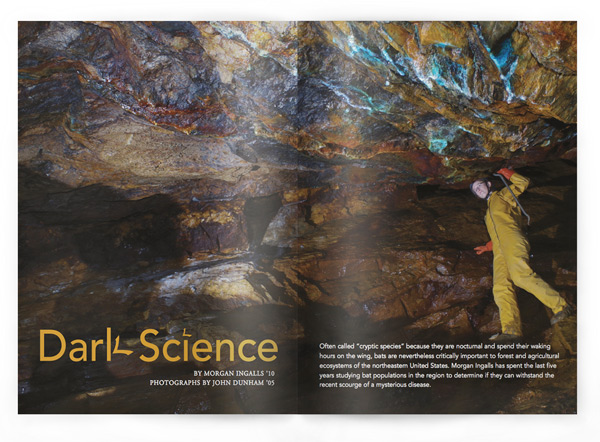
By Morgan Ingalls ’10
Photographs by John Dunham ’05
Often called “cryptic species” because they are nocturnal and spend their waking hours on the wing, bats are nevertheless critically important to forest and agricultural ecosystems of the northeastern United States. Morgan Ingalls has spent the last five years studying bat populations in the region to determine if they can withstand the recent scourge of a mysterious disease.
It’s mid-January in southwestern Vermont and, with the blustery windchill, the high for the day won’t make it out of the single digits. I’m helping the Vermont Fish and Wildlife Department conduct a winter hibernacula survey—in other words, I’m going to spend the day in a cave, counting bats. I’m joined by two friends, both experienced cavers, and a technician from the state agency. The cave we’re headed to is about a mile up a steep mountainside, and the ground is covered by ice and a thin layer of powdery snow, but together we claw our way to the cave entrance.
It’s a relief to get out of the wind and into the relative warmth of the 42-degree cave. Caves are the same temperature year round, making them perfect places for bats to hibernate. Vermont bat species that don’t migrate south for the winter spend the early autumn fattening up on insects, then in late October they find a cave and settle down for the winter. By dropping their body temperature to within a few degrees of the ambient temperature, they can hibernate until the insect populations return in the spring and they can have another meal.
To survive the winter by hibernating, bats have to slow down their entire physiology to conserve energy. Their heartbeats decrease from a brisk 400 beats per minute to 25 beats per minute. They also have to slow down their immune systems, which leaves them vulnerable to infection. This has recently become a major problem for bats in the eastern United States as more and more of them succumb to white-nose syndrome (WNS), one of the primary reasons for my visit to this Vermont cave.
WNS is a fungal infection that attacks the face, ears, and wing membranes of bats while they hibernate. The syndrome was first seen in the Albany, New York, area in the winter of 2006, and has since spread to 29 states (including Vermont) and five Canadian provinces. While scientists are still not sure exactly how WNS kills bats, it is believed that the disease causes bats to stir from hibernation more often, which quickly drains their fat reserves. This means that many bats die from starvation and dehydration over the winter. Those bats that do make it through to spring continue to face challenges, as damage to their wing membranes leaves some unable to fly for their first meal in five months.
About 50 feet into the cave we see our first bat. It turns out to be an exciting find: a northern long-eared bat. While northern long-eared bats used to be abundant throughout the northeast, their populations have declined so drastically due to WNS that they were recently listed as federally threatened under the Endangered Species Act.
As we continue through the cave, we see three other species: little brown bats, big brown bats, and eastern small-footed bats. All three of these species have suffered population declines of varying extent due to WNS. When we climb back out of the cave after six hours underground, we’ve counted 19 bats. Ten years ago, 19 bats would hardly be worth reporting, but now, post-WNS, it’s a pretty good day.
When bats emerge from hibernation in the spring, the females move to maternity colonies where they’ll spend the next few months giving birth and caring for their pups. The maternity colonies can be up to 300 miles from their hibernation site, and females will return to the same colony year after year. Males also migrate away from the hibernation site, to foraging areas where they’ll spend the summer alone or with a few other males in “bachelor colonies.” Once juveniles are old enough to fly, males and females form fall “swarms” at cave and mine entrances, where they’ll mate and bulk up on fat for the hibernation season.
•••
Now it’s July on the coast of Maine and I’m at Acadia National Park, tracking female eastern small-footed bats in order to find maternity colonies. My team and I have been capturing bats using mist-nets: very fine nets that we place across travel corridors such as roads and trails. We open the nets around sunset and sit nearby battling the mosquitos, reading, playing cards, and checking the net every 10 minutes to see if we’ve captured a bat.
It’s my turn to check the net, and I can see when I get close enough that we’ve caught both one large and one small bat. I pull on nitrile gloves and gently grab the smaller bat. Untangling bats from mist-nets can be pretty tricky and requires a delicate touch, but also speed. Bats can become stressed if left for too long, so we try to minimize the time a bat is stuck in the net. I remove the strands of net one at a time from the bats’ feet and wings.
I bring both bats back to a camp table where we can collect some data. My co-worker, Carl, gets out a data sheet and records data while I get the smaller bat—an eastern small-footed bat—out of the paper bag it has been held in. This bat is a lactating female, which makes her of particular interest to us, since she could lead us back to a maternity colony. We also measure her forearm— the longest bone in the wing—and her ears. Then we put her in a small envelope and weigh her. She weighs about six grams, or very slightly more than a U.S. quarter. Finally, we use a small light to backlight the wings and determine how scarred they are from WNS damage.
This bat appears to be quite healthy, and we decide she’s a good candidate to track using radio-telemetry. To do this we affix a transmitter to the animal, a device that beeps on a specific radio frequency that can be detected using a receiver. The transmitters we’re using are some of the smallest available, slightly smaller than half a peanut, with a thin flexible antenna attached to one end. Altogether, the transmitters weigh about 0.3 grams, or about as much as four grains of rice.
Carl holds the bat with its wings and head down, exposing the bat’s back. Using small nail scissors, I give the bat a tiny haircut between the shoulder blades. I then put a dab of glue on the transmitter and position it onto the bald spot so the antenna runs down the bat’s back and off its tail. We put the bat back in a paper bag for 10 to 15 minutes to allow the glue to set, then release it back into the night. The transmitter battery and the glue will last three to four weeks. During that time we’ll be able to track the bat as it moves across the landscape.
The morning after we’ve trapped our female eastern small-footed bat, Carl and I drive around the park, listening for the beeps on the receiver that will indicate that we’re close to the animal. After two hours of driving, we finally pick up the signal of our bat. Using a directional antenna, we determine that the bat is roosting in a rocky area on the side of a mountain. We hike through the woods, scramble up outcrops, and finally locate our bat roosting deep in a crack on a sunny granite ledge. While we can’t actually see her, the signal from her transmitter assures us she is there.
That evening, to find out if our bat has led us to a maternity colony, we hike back up to the ledge a half hour before sunset. We find a spot where the sky will backlight any emerging bats, and settle in to count. Just before sunset, we see a bat emerge, but we know it isn’t our bat since the signal on the receiver tells us she’s still in the same location. In the next 15 minutes we see six more bats emerge, including ours. We can tell when she’s left because the signal on the receiver slowly fades as she flies away from us, off into the night.
While seven bats does not make for a large maternity colony (some other species form maternity colonies in the hundreds or even thousands), this maternity colony is a good size for this species in this region. Over the next few weeks we’ll continue to track this individual, as well as others, collecting more information about how these bats use the landscape.
In addition to being important for the natural environment, bats provide a number of ecosystem services to humans. Along with reducing the number of biting insects, bats are responsible for an estimated savings of $22.9 billion per year for the agricultural industry in the United States through pest reduction. While WNS has been devastating for bat populations, it has brought much-needed funding to bat research. Unfortunately, it may be too little, too late. Since bats reproduce at a very slow rate (for most species in the northeast, females give birth to one pup per year), building populations back to pre-WNS numbers may take hundreds of years. For some species, such as the federally listed northern long-eared bat, populations may already be too small to recover.
However, bat populations in New York and New England do show some signs of recovery. Population estimates based on winter hibernacula surveys are no longer dropping, but starting to plateau. This makes some researchers hopeful that we’ll soon start to see populations increase. While recovery from WNS will take a long time, the work researchers are doing to better understand bats and how they use the landscape can lead to more effective conservation measures, which might save some species.
After I’ve finished tracking my bats around Acadia National Park, I return to Vermont for the winter. Late fall is a slow time of year for bats and bat biologists. Bats are done with their fall swarm and settled for a long hibernation. Biologists sit in their warm homes and write up reports from the summer field season. However, come January, emails start flying and trips are planned for winter hibernacula counts. Soon, I’ll be squeezing into another cave entrance to go count some bats.
Morgan Ingalls graduated from Marlboro in 2010 with a Plan in biochemistry, including a study of white-nose syndrome and population decline in bats. Morgan has worked for Biodiversity Research Institute doing summer and fall bat habitat surveys for federal agencies, and has regularly helped regional state agencies with winter bat surveys. John Dunham runs the writing center at Antioch University New England. He is also a leader of Outdoor Program caving excursions and current president of the Vermont Cavers Association.
Graphic Animal Behavior
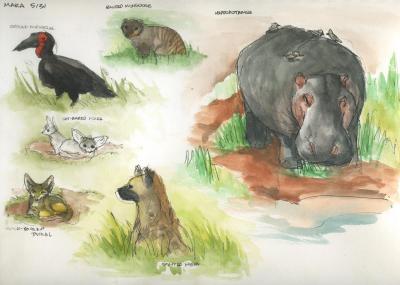 “I think spotted hyenas are really beautiful, in their own ghoulish way—I love their odd proportions,” says senior Nellie Booth, who is doing their Plan of Concentration in biology and visual arts. They spent two and a half weeks in Kenya last summer, touring Masai Mara, Samburu, and Lake Nakuru national parks and doing wildlife observations and field sketches, the basis for a narrative graphic novella about spotted hyena behavior. “I call it animal behavior fiction,” Nellie says of their biologically accurate book, titled Queen of the Mara. They are also exploring animal behavior and emotion through research on ravens; an exhibit of sculptures exploring themes of nature, birth, and death; and an educational card game about evolutionary adaptation. “I’m interested in connections between humans and nonhuman animals, including enrichment for captive animals.”
“I think spotted hyenas are really beautiful, in their own ghoulish way—I love their odd proportions,” says senior Nellie Booth, who is doing their Plan of Concentration in biology and visual arts. They spent two and a half weeks in Kenya last summer, touring Masai Mara, Samburu, and Lake Nakuru national parks and doing wildlife observations and field sketches, the basis for a narrative graphic novella about spotted hyena behavior. “I call it animal behavior fiction,” Nellie says of their biologically accurate book, titled Queen of the Mara. They are also exploring animal behavior and emotion through research on ravens; an exhibit of sculptures exploring themes of nature, birth, and death; and an educational card game about evolutionary adaptation. “I’m interested in connections between humans and nonhuman animals, including enrichment for captive animals.”
Panoptic Wilderness
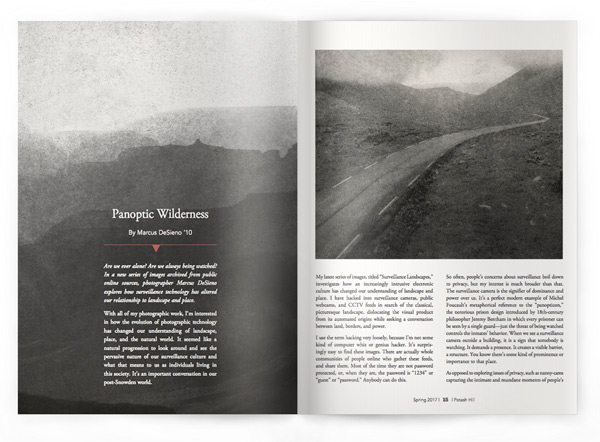
By Marcus DeSieno ’10
Are we ever alone? Are we always being watched? In a new series of images archived from public online sources, photographer Marcus DeSieno explores how surveillance technology has altered our relationship to landscape and place. With all of my photographic work, I’m interested in how the evolution of photographic technology has changed our understanding of landscape, place, and the natural world. It seemed like a natural progression to look around and see the pervasive nature of our surveillance culture and what that means to us as individuals living in this society. It’s an important conversation in our post-Snowden world.
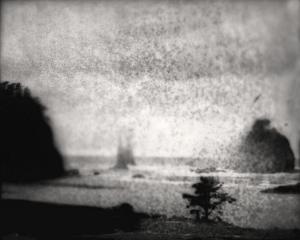 My latest series of images, titled “Surveillance Landscapes,” investigates how an increasingly intrusive electronic culture has changed our understanding of landscape and place. I have hacked into surveillance cameras, public webcams, and CCTV feeds in search of the classical, picturesque landscape, dislocating the visual product from its automated origins while seeking a conversation between land, borders, and power.
My latest series of images, titled “Surveillance Landscapes,” investigates how an increasingly intrusive electronic culture has changed our understanding of landscape and place. I have hacked into surveillance cameras, public webcams, and CCTV feeds in search of the classical, picturesque landscape, dislocating the visual product from its automated origins while seeking a conversation between land, borders, and power.
I use the term hacking very loosely, because I’m not some kind of computer whiz or genius hacker. It’s surprisingly easy to find these images. There are actually whole communities of people online who gather these feeds, and share them. Most of the time they are not password protected, or, when they are, the password is “1234” or “guest” or “password.” Anybody can do this.
So often, people’s concerns about surveillance boil down to privacy, but my interest is much broader than that. The surveillance camera is the signifier of dominance and power over us. It’s a perfect modern example of Michel Foucault’s metaphorical reference to the “panopticon,” the notorious prison design introduced by 18th-century philosopher Jeremy Bentham in which every prisoner can be seen by a single guard—just the threat of being watched controls the inmates’ behavior. When we see a surveillance camera outside a building, it is a sign that somebody is watching. It demands a presence. It creates a visible barrier, a structure. You know there’s some kind of prominence or importance to that place.
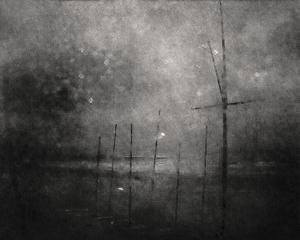 As opposed to exploring issues of privacy, such as nanny-cams capturing the intimate and mundane moments of people’s lives, it seemed more interesting to me to look out at landscapes that were devoid of humans. The melancholic images that I’m assembling speak to how this technology shapes our understanding of place, and evoke conversations around power and ownership. That really intrigues me: why, on this road in the middle of nowhere, Kansas, is there a surveillance camera? Some of the locations, such as those in national parks, have a certain prominence or significance. But most of the places I stumble upon have no rhyme or reason. Maybe it’s a traffic camera; maybe it’s a weather camera. This technology is used for a variety of purposes besides the nefarious, but it certainly shapes our psyche when we see these things.
As opposed to exploring issues of privacy, such as nanny-cams capturing the intimate and mundane moments of people’s lives, it seemed more interesting to me to look out at landscapes that were devoid of humans. The melancholic images that I’m assembling speak to how this technology shapes our understanding of place, and evoke conversations around power and ownership. That really intrigues me: why, on this road in the middle of nowhere, Kansas, is there a surveillance camera? Some of the locations, such as those in national parks, have a certain prominence or significance. But most of the places I stumble upon have no rhyme or reason. Maybe it’s a traffic camera; maybe it’s a weather camera. This technology is used for a variety of purposes besides the nefarious, but it certainly shapes our psyche when we see these things.
A lot of this work is about being an archivist, having a selection process, trying to find those moments that present a heightened emotional state, or aesthetic moments that interest me. Essentially, I’m a curator of the surveillance internet. I find this really intriguing because I’m not only thinking about the nature of the technology, but of another layer—the ways in which I’m using the internet to construct this work. I deflate this idea of the artist as genius by using what’s available to me, what’s available to anybody.
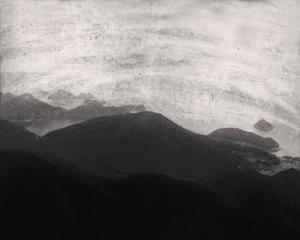 I don’t alter the images, other than converting the ones in color to black and white. I like the starkness of the monochromatic image, which perhaps heightens the sense of drama. Black and white dislocates the landscape, so the identifiers of place are more limited. Much of the time I specifically seek out imagery that’s in soft focus, that has an impressionistic feel, that might have raindrops on the lens. I’m interested in cameras that might be grimy, and haven’t been serviced for a while—in finding imagery that abstracts the landscape in some way, that can speak to a history of landscape painting as well. It’s just another layer to this work, another vector in the history of how we perceive the landscape.
I don’t alter the images, other than converting the ones in color to black and white. I like the starkness of the monochromatic image, which perhaps heightens the sense of drama. Black and white dislocates the landscape, so the identifiers of place are more limited. Much of the time I specifically seek out imagery that’s in soft focus, that has an impressionistic feel, that might have raindrops on the lens. I’m interested in cameras that might be grimy, and haven’t been serviced for a while—in finding imagery that abstracts the landscape in some way, that can speak to a history of landscape painting as well. It’s just another layer to this work, another vector in the history of how we perceive the landscape.
Through these empty landscapes I want to create a contemplative state of mind. When my viewer looks at the images—when they’re taken into these landscapes— they can reflect on their own relationship to surveillance technology and how it’s affected them, whether they know it or not. The very act of someone surveying a site through these photographic systems implies a dominating relationship between man and place. Ultimately, I hope to undermine these schemes of social control through the obfuscated, melancholic images found while exploiting the technological mechanisms of power in our surveillance society.
Marcus DeSieno received his MFA in studio art from the University of South Florida, and is currently a visiting photography professor at Marlboro. Marcus’s work has been exhibited nationally and featured in a variety of publications, from Smithsonian to Wired. In August, his “Surveillance Landscapes” series was selected for Photolucida’s Critical Mass Top 50, a juried competition for emerging photographers, for pushing the boundaries of the medium. This has led to a book deal with Daylight, a nonprofit publisher of fine art and photography books.
Corrupted Video Files
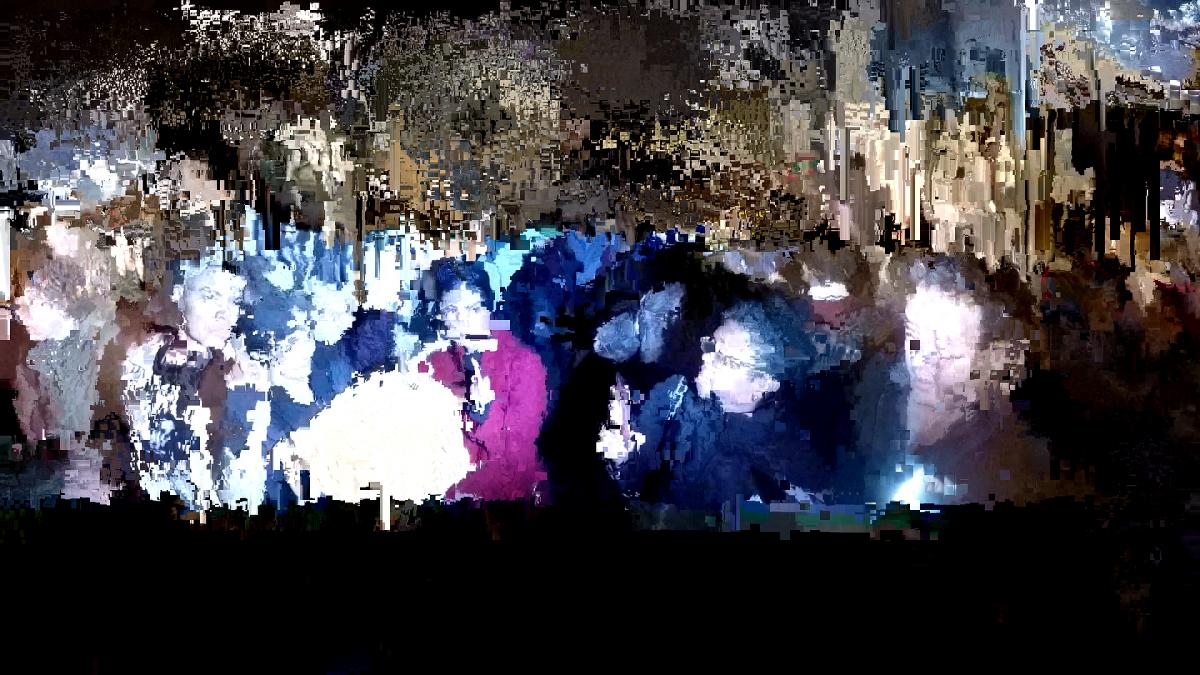 “The videos of David Hall were meant to take the viewer out of the conventional televisual experience,” says senior Ian Grant, referring to the artist who introduced “TV Interruptions” on Scottish television in the 1970s. “Much like Hall, my own work will often critique the culture of mainstream media, and creates an aesthetic with this in mind.” Ian is completing his Plan of Concentration in visual arts, with a written portion on British video art in the 70s and 80s and an exhibit of photographs, video art, and video installation. “My work often involves a new art form called ‘glitch art,’ which causes the viewer to question their experience.” An example of this (left) shows a still from corrupted video files Ian took during the anti-Trump protest in New York City the night after the election.
“The videos of David Hall were meant to take the viewer out of the conventional televisual experience,” says senior Ian Grant, referring to the artist who introduced “TV Interruptions” on Scottish television in the 1970s. “Much like Hall, my own work will often critique the culture of mainstream media, and creates an aesthetic with this in mind.” Ian is completing his Plan of Concentration in visual arts, with a written portion on British video art in the 70s and 80s and an exhibit of photographs, video art, and video installation. “My work often involves a new art form called ‘glitch art,’ which causes the viewer to question their experience.” An example of this (left) shows a still from corrupted video files Ian took during the anti-Trump protest in New York City the night after the election.
On and Off the Hill
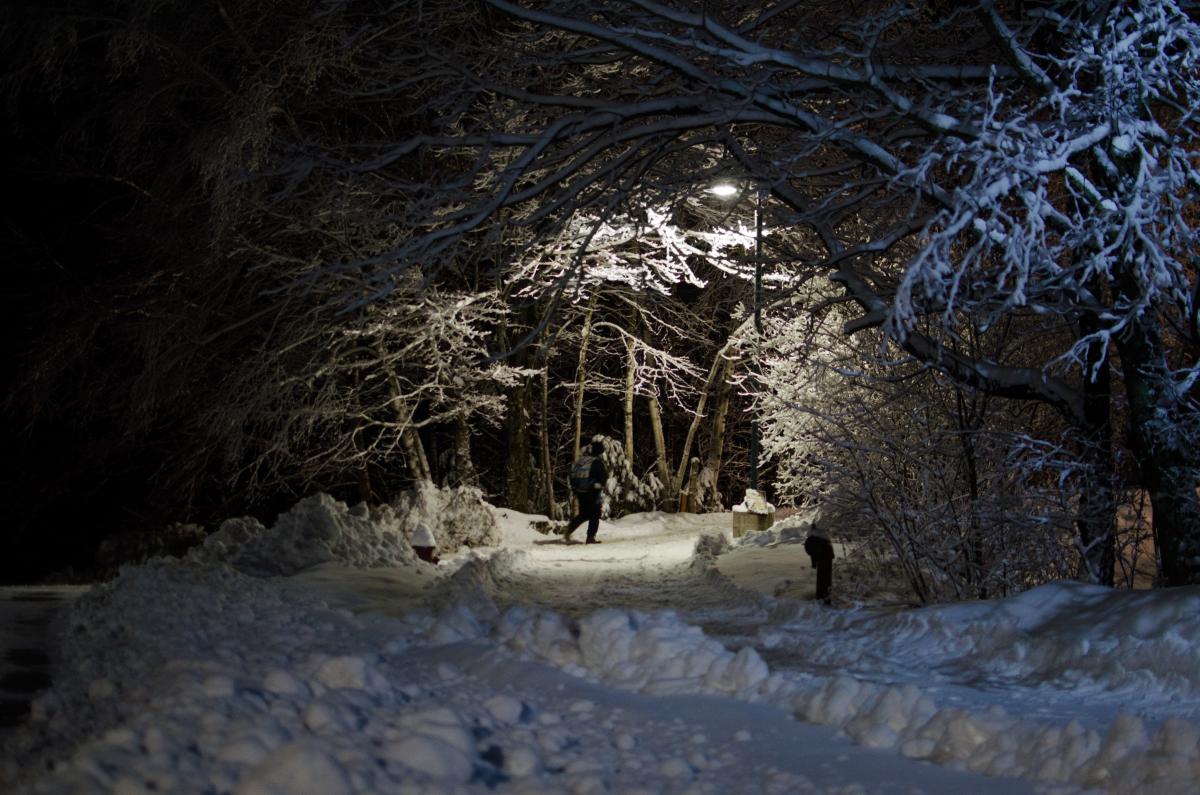
New Students Build Community Skills
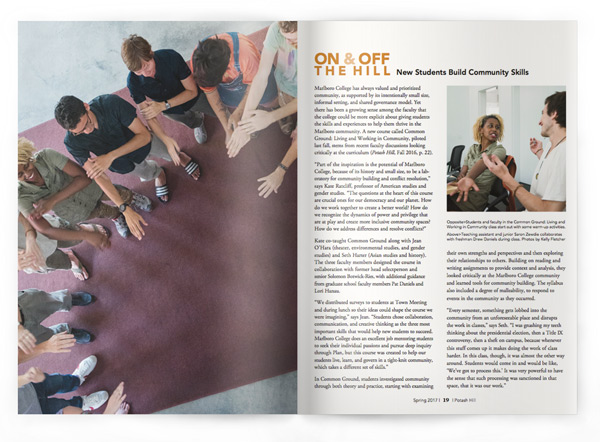
Marlboro College has always valued and prioritized community, as supported by its intentionally small size, informal setting, and shared governance model. Yet there has been a growing sense among the faculty that the college could be more explicit about giving students the skills and experiences to help them thrive in the Marlboro community. A new course called Common Ground: Living and Working in Community, piloted last fall, stems from recent faculty discussions looking critically at the curriculum (Potash Hill, Fall 2016).
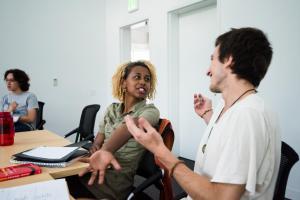 “Part of the inspiration is the potential of Marlboro College, because of its history and small size, to be a laboratory for community building and conflict resolution,” says Kate Ratcliff, professor of American studies and gender studies. “The questions at the heart of this course are crucial ones for our democracy and our planet. How do we work together to create a better world? How do we recognize the dynamics of power and privilege that are at play and create more inclusive community spaces? How do we address differences and resolve conflicts?”
“Part of the inspiration is the potential of Marlboro College, because of its history and small size, to be a laboratory for community building and conflict resolution,” says Kate Ratcliff, professor of American studies and gender studies. “The questions at the heart of this course are crucial ones for our democracy and our planet. How do we work together to create a better world? How do we recognize the dynamics of power and privilege that are at play and create more inclusive community spaces? How do we address differences and resolve conflicts?”
Kate co-taught Common Ground along with Jean O’Hara (theater, environmental studies, and gender studies) and Seth Harter (Asian studies and history). The three faculty members designed the course in collaboration with former head selectperson and senior Solomon Botwick-Ries, with additional guidance from graduate school faculty members Pat Daniels and Lori Hanau.
“We distributed surveys to students at Town Meeting and during lunch so their ideas could shape the course we were imagining,” says Jean. “Students chose collaboration, communication, and creative thinking as the three most important skills that would help new students to succeed. Marlboro College does an excellent job mentoring students to seek their individual passions and pursue deep inquiry through Plan, but this course was created to help our students live, learn, and govern in a tight-knit community, which takes a different set of skills.”
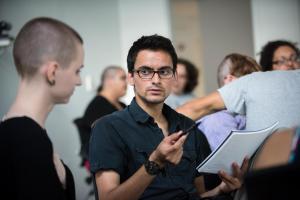 In Common Ground, students investigated community through both theory and practice, starting with examining their own strengths and perspectives and then exploring their relationships to others. Building on reading and writing assignments to provide context and analysis, they looked critically at the Marlboro College community and learned tools for community building. The syllabus also included a degree of malleability, to respond to events in the community as they occurred.
In Common Ground, students investigated community through both theory and practice, starting with examining their own strengths and perspectives and then exploring their relationships to others. Building on reading and writing assignments to provide context and analysis, they looked critically at the Marlboro College community and learned tools for community building. The syllabus also included a degree of malleability, to respond to events in the community as they occurred.
“Every semester, something gets lobbed into the community from an unforeseeable place and disrupts the work in classes,” says Seth. “I was gnashing my teeth thinking about the presidential election, then a Title IX controversy, then a theft on campus, because whenever this stuff comes up it makes doing the work of class harder. In this class, though, it was almost the other way around. Students would come in and would be like, ‘We’ve got to process this.’ It was very powerful to have the sense that such processing was sanctioned in that space, that it was our work.”
This work included President Kevin coming to class for a debriefing about the presidential election, a conversation that affected everyone deeply. It also contributed to a communique from Kevin to the college community about not tolerating xenophobia on campus.
“It was powerful for students to see the president show up to class and then immediately respond,” says Jean. “That they felt comfortable sharing honestly, despite him coming in, also speaks to the amount of work we did as a group. They understood that these conversations have to happen with everybody, not just in this classroom. This isn’t a rehearsal.”
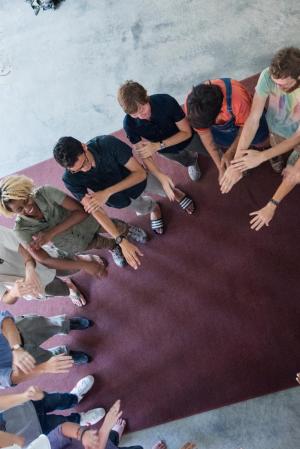 “As we developed trust among the micro-community of the class, we began to cultivate a warm, inviting atmosphere,” says Solomon Botwick-Reis, who also acted as one of three teaching assistants. “The course was a transformative space of tenderness—tender vulnerability with each other, with issues in the Marlboro community, and with the broader realities of our nation and world.”
“As we developed trust among the micro-community of the class, we began to cultivate a warm, inviting atmosphere,” says Solomon Botwick-Reis, who also acted as one of three teaching assistants. “The course was a transformative space of tenderness—tender vulnerability with each other, with issues in the Marlboro community, and with the broader realities of our nation and world.”
Students put theory into practice in the form of community-based projects that they designed and co-created, building on the sense of reciprocity and responsibility essential to community. These projects focused on issues around classism at Marlboro, public education about smoking, and helping art students to cover materials costs.
“I began to grasp the extent to which Marlboro students can impact their campus community,” says freshman Adeel Sultan, whose group piloted a Creative Arts Co-op where students can sell their art and help other students afford art supplies. “Coming out of that experience, I feel empowered and ready to collaborate with others on future projects that benefit the community.”
“Students learned a lot about the challenges of working together, and came to a new appreciation of the difficulty of organizing and publicizing events on campus—all of that I think was a real eye-opener to them,” says Seth. “Their project equipped students with the knowledge they need, and the tools they need, to be better community members. This included an appreciation for the work of staff, and seeing that their roles are very complicated.”
“The highlight of the class for me was the intentional way we created a community in the class itself,” says Kate. “Peter Block [author of Community: The Structure of Belonging] emphasizes the idea that community is not something that exists in a pre-formed way, but is more a way of being with ourselves and each other to create change. I was profoundly moved by the work we did together in the classroom.”
Jennifer Girouard Brings It All Back to Marlboro
“My experience at Marlboro was very intense, in a good way,” says Jennifer Girouard, who graduated in 2001 with a Plan of Concentration exploring the sociology of white-collar labor. A first-generation college student, Jennifer didn’t know what to expect, so she threw herself into the Marlboro experience full steam. “I didn’t actually know what sociology was—they didn’t teach it at my high school, so I had no idea—I just got swept into it,” she says. Now, 15 years later, Jennifer is on the other side of that intense experience, as Marlboro’s new sociology professor.
“Sociology is such a broad field,” says Jennifer, reflecting on how she first gravitated toward the discipline. “It was a lens to understand the world in a new way, and to understand my own life trajectory. I think what’s always interesting for students is when they understand some of the large structural forces and start to put together pieces of ‘how did I end up here?’ Seeing that bigger picture is very useful for me. I got sucked into viewing the world through that lens, and I didn’t leave it.”
Jennifer received her doctorate in sociology from Brandeis University, but before continuing on to graduate school she spent five years working with children at a homeless shelter in Massachusetts and for Head Start in Appalachian Ohio. In the latter, she worked one-on-one with preschoolers and their families to build new skills, broaden early development experiences, and monitor their progress.
“Only when I was thinking of coming back to Marlboro did I realize that these meetings were like doing little family tutorials, sitting together and working through what was important to them,” says Jennifer. “These experiences challenged and immersed me in new social and cultural milieu, and honed my sociological lens.”
Jennifer’s doctoral dissertation, titled “When Law Comes to Town: Participation and Discourse in Fair-Share Affordable Housing Hearings,” was based on a study of four towns’ implementation of a state affordable-housing law. She was particularly interested in tracking the discourse of small-scale public hearings where everyone got together and talked—or yelled—about an issue, a forum with interesting similarities to Marlboro’s Town Meetings. Jennifer is co-editor of Varieties of Civic Innovation: Deliberative, Collaborative, Network, and Narrative Approaches.
Jennifer says that many of the things that drew her in as a Marlboro student continue to inspire her as a professor. She started teaching in the fall already aware that Marlboro’s professors are constantly being challenged and pushed to new subjects by students, to a degree rarely found at other institutions.
“When a student comes to me with an interest, I get to expand and learn alongside them. Having been a student, I understood that this was part of the job, and that’s what excited me to come back. I’m currently working with a student on immigration in Sweden. I don’t know anything about that, but now I get to learn it, and it benefits me, the student, and other students that come after.”
With a discipline as broad-ranging as sociology—essentially the study of the social world—Jennifer expects many fascinating diversions driven by student interest. She’s also eager to provide opportunities for students to participate in her ongoing research, exploring competing structures and cultural discourse through local land-use conflicts.
“I’m always interested in how we construct and contest space and land use, and I’m sure there are a lot of really interesting ways to build on that here,” Jennifer says. “I’m very interested in how we view and regulate different housing types, such as trailer parks, which here in Vermont were the hardest hit by Tropical Storm Irene.”
Jennifer recognizes that she is rejoining Marlboro at a really interesting transitional time period. There’s a lot of new energy coming in with students, and there’s a shift in faculty—with concomitant discussions of changes in the curriculum. She is excited to see what comes of these conversations, but thinks there are some core things that won’t change.
“Marlboro does so well at preparing students to think richly, deeply about the world. I was just telling Jerry [Levy, sociology professor emeritus] that when I started my doctoral program without a master’s degree, I felt completely prepared. Marlboro doesn’t prepare students for specific jobs or different career paths, but it shapes their minds in ways that are very effective, if hard to measure.”
Partner Colleges Come to Campus
In October, Marlboro College co-hosted the annual meeting for the Consortium for Innovative Environments in Learning (CIEL), a working group of 12 institutions founded on innovative and student-centered practices in higher education. A group of more than 30 colleagues from partner colleges across the country convened at Marlboro to meet with President Kevin and discuss shared governance and community engagement on campus.
“All of our CIEL partners excel in different ways to produce life-long learners and engaged citizens, but Marlboro has a unique history of leadership in the area of shared governance,” said Richard Glejzer, dean of faculty. “Together we discussed curricular initiatives and decision-making models that prepare students for a lifetime of community engagement, service, and stewardship.”
“In class, I might be Solomon’s boss, but on select board, he’s my boss,” said mathematics professor and select board member Matt Ollis, referring to head selectperson Solomon Botwick-Ries. “Except for the fact that neither is an especially boss-like relationship.” The session was followed by a reception and dinner in the campus center, where participants discussed new developments at partner institutions Green Mountain College and University of Maine at Farmington.
The CIEL meeting was cohosted by Bennington College, which offered workshops on intellectual mentorship and experiential learning. Bennington President Mariko Silver hosted a lunch discussion about equity and inclusion and the impact of recent events on aspects of civility and community on campus.
Dual Graduates Go for the Whole Marlboro
“My first residency weekend had me experiencing deja vu,” said Heidi Doyle ’94 MAT ’16 in her student address at commencement last May, referring to her experience in the graduate program. “The discussions that took place, the rigor of the work, and the self-pacing that was required seemed strangely familiar. . . I was beginning to have a sneaking suspicion that the undergraduate and the graduate campuses valued the same things.”
Heidi was the first “dual” alumnus to address the first-ever combined undergraduate-graduate commencement (Potash Hill, Fall 2016), and she gave a fitting tribute to what is a growing phenomenon. Marlboro students are finding valuable continuities and rewarding careers by following their undergraduate degree with one of the college’s graduate programs.
“Nearly 30 students, with several more on the way, have completed both their bachelor’s and master’s degrees at Marlboro, bringing theory into practice through a graduate program in teaching or management,” says Kate Jellema, associate dean for graduate and professional studies. “We have much to learn from these ‘bi-lumni,’ and their positive stories are even more poignant as we move the graduate program to Potash Hill this year."
“The two programs have so much in common: extraordinary faculty, small classes, emphasis on community, and the opportunity for each student to study and pursue what he or she is most passionate about,” says Sarah Swift ’04, who completed her Capstone for an MS in Management in December. Sarah’s Plan in sociology and photography focused on the social and psychological aspects of dying and grieving, including making photographic quilts with people facing end-of-life issues. For her Capstone she established a nonprofit called Sewing Our Stories.
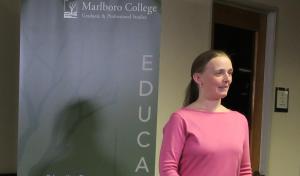 “I felt drawn to figuring out how to develop a nonprofit that could use traditional crafts, such as the photographic quilting I’d done for my Plan, with people at the end of life as a way to honor and affirm their lives,” says Sarah, who works at a hospice council in Augusta, Maine. “In a way, my graduate Capstone felt like an extension of my Plan— with the support of my coursework and faculty adviser, I was able to develop and launch this nonprofit project.”
“I felt drawn to figuring out how to develop a nonprofit that could use traditional crafts, such as the photographic quilting I’d done for my Plan, with people at the end of life as a way to honor and affirm their lives,” says Sarah, who works at a hospice council in Augusta, Maine. “In a way, my graduate Capstone felt like an extension of my Plan— with the support of my coursework and faculty adviser, I was able to develop and launch this nonprofit project.”
Adam Katrick ’07 did his Plan in biology and writing, specifically wolf biology, and last fall completed his MS in Management with a concentration in nonprofit management. In the process he has started his own nonprofit to teach people in the region about wolves, called Wolfgard Northeast, and is embarking on a campaign to build a wolf center in Southern Vermont.
“We’ve got a really dynamic, energized board of directors, a number of dedicated supporters, and have run programs from New York City to Burlington and many places in between,” says Adam, who lives in Marlboro. “Every week I get the opportunity to teach people about wolves. I’m more immersed in my relationship with the wilderness and wolves than ever before. It’s such a joy to see people’s faces when I tell them we’re building a wolf center—there’s so much excitement there.”
“I found that having gone through the Plan process made the Capstone project at the end of my graduate program far less intimidating,” says Francisco Mugnani ’10 MAT ’14. Francisco’s Plan in film/video studies focused on examining patterns in the narrative structure of hero myths, and his Capstone involved creating an online course to learn video production. “In both projects I worked one-on-one with a professor, set goals, and worked toward a project that exhibited my learning. The Capstone was different, however, in that the focus was more on applying my learning to help another person or organization.”
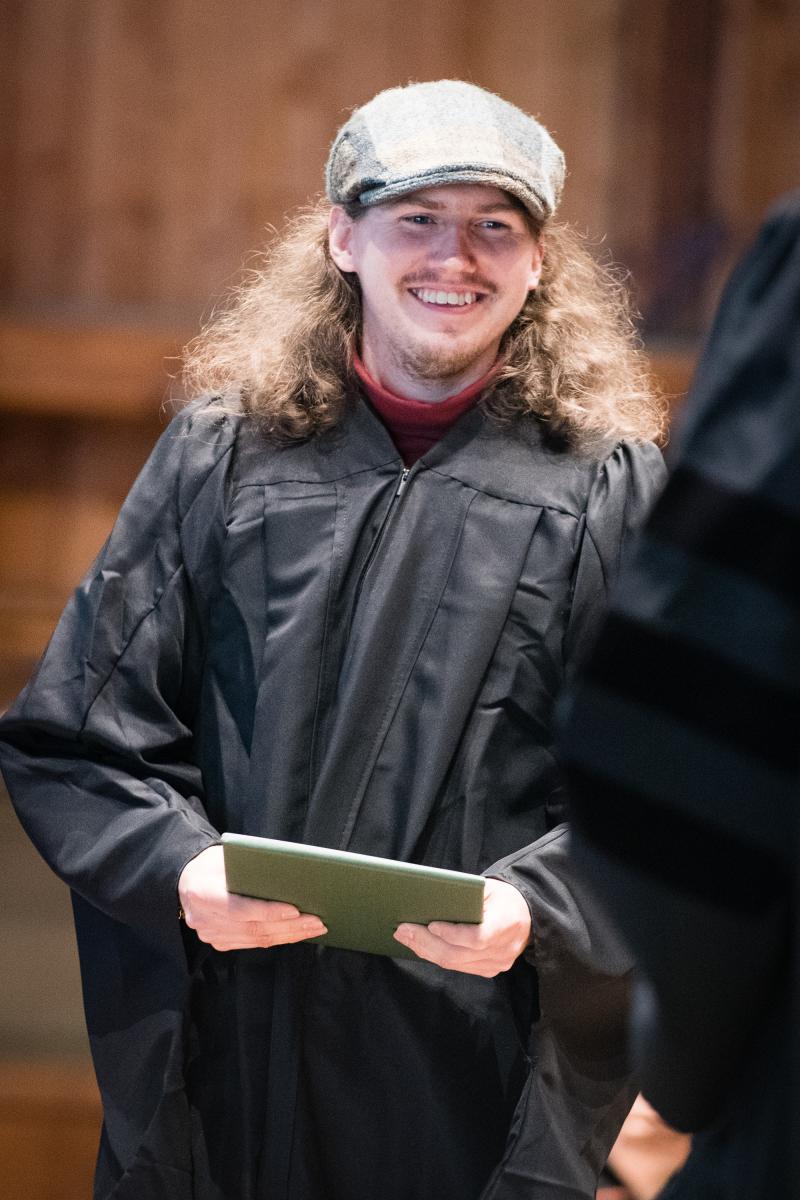 Francisco has gone on to work as a media producer and teacher, giving film instruction and helping out with several independent video projects, most often in schools. He is currently working at the Brooks Memorial Library in Brattleboro. “I delight in helping kids find their books and in witnessing firsthand how the library is working to evolve with emerging technologies and new ideas about how people learn,” he says.
Francisco has gone on to work as a media producer and teacher, giving film instruction and helping out with several independent video projects, most often in schools. He is currently working at the Brooks Memorial Library in Brattleboro. “I delight in helping kids find their books and in witnessing firsthand how the library is working to evolve with emerging technologies and new ideas about how people learn,” he says.
Geordie Morse ’13 MATESOL ’16 did his Plan on Asian studies and education, specifically on issues concerning the contemporary Japanese education system, such as how history textbooks influenced, and were influenced by, modern politics and culture. After graduating from Marlboro he spent a year gaining valuable firsthand experience as an English teacher in Japan, then returned to get his MA in TESOL.
“I wanted to continue my studies in an institution that shared Marlboro’s ideals and ethics of education,” says Geordie. “I was looking for small class sizes and a program that made my contributions feel worthwhile. What stands out to me about the graduate program is how dedicated and passionate the professors are about the mission of their programs, and how much care and attention they are willing to give their students to help them succeed.”
“My favorite thing about the graduate program was the conversations during the face-to-face weekends,” says Heidi Doyle, who is now a library media and technology integration specialist at Sunapee Central Elementary School in New Hampshire. “Because all of my classmates came from such diverse backgrounds, they brought a unique perspective to the conversation. We were all trying to accomplish the same goals, but our purpose and intent for those goals were vastly different.”
Like many “bi-lumni,” Heidi found similarities between her undergraduate and graduate experiences, including the rigor of work, the quality of discussion, and a certain “quirkiness.” “Small class sizes and intimate relationships with classmates and professors is prevalent in both programs. Those relationships enrich both your professional and personal life and provide a safe environment for taking risks.”
Or in Francisco’s apt words, “If you think of Marlboro undergrad as a movie, the Marlboro graduate program is like a great sequel. It preserves many of the core elements that made the original successful, but expands it in a bold new direction.”
Although not technically a dual alumnus, Ahmed Salama drives home the idea that there is something synergistic in Marlboro’s undergraduate and graduate programs. A native of Egypt, Ahmed taught Arabic to undergraduate students as Marlboro’s Fulbright Fellow for Arabic Language in the 2008–2009 academic year. After working for several years as head of the foreign languages department at Learning Services and Solutions Center in El Mahalla El Kubra, Egypt, Ahmed was back at Marlboro last summer, participating in the MA in TESOL program.
Storied Faculty Members Move On
Three of Marlboro’s most senior faculty will be retiring this academic year, after a combined 134 years of dedicated service to the college and mentorship to countless adoring students. The college made the decision to remove a retirement benefit introduced in 2007, for budgetary reasons, and T. Wilson (literature and writing), Geraldine Pitmann de Batlle (literature), and Stan Charkey (music) elected to take the benefit before it disappeared.
 “How does one describe the singular, formative love between teacher and student?” asks Amanda DeBisschop ’10, who was one of T.’s Plan students and is now a teacher herself at Leland & Gray High School in Townshend, Vermont. We’re not sure we have the answer, but we figure that former students of these formidable faculty members will be in the best position to take a stab at it.
“How does one describe the singular, formative love between teacher and student?” asks Amanda DeBisschop ’10, who was one of T.’s Plan students and is now a teacher herself at Leland & Gray High School in Townshend, Vermont. We’re not sure we have the answer, but we figure that former students of these formidable faculty members will be in the best position to take a stab at it.
Amanda continues, “From the first, I knew that I wanted to know T. Hunter Wilson. I felt soon after seeing him on campus, at Town Meeting, that there was something I had to learn from him. And what I learned was the incredible feeling of someone taking my writing seriously. In my entire life, there had been no one to assess my work on an academic level. He helped me to feel credible. He treated my work as though it were a contribution to the larger world of poetry. He also taught me the value of accountability in a partnership, both as a student and doubly as a teacher, now, of my own students.”
T. first taught writing and literature at Marlboro in 1968, after receiving his MFA from the University of Iowa Writers’ Workshop, and in addition to teaching he has done stints as dean of faculty and, twice, as director of the World Studies Program. Always engaged in the campus community, he has served as Town Meeting moderator, Community Court justice, and member of countless committees.
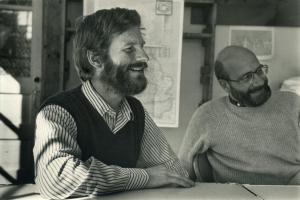 “I still, 40-plus years later, vividly remember the eagerness with which I looked forward to our meetings,” says Kathryn Kramer ’75, now a published author and professor of literature at Middlebury College. “I could have listened from dawn till dusk to T. talking about my manuscript. This kind of attention, this kind of uninflected reading, is an enormous gift to a young writer, and I have remembered that experience over the years as I’ve gone on to teach writing myself.”
“I still, 40-plus years later, vividly remember the eagerness with which I looked forward to our meetings,” says Kathryn Kramer ’75, now a published author and professor of literature at Middlebury College. “I could have listened from dawn till dusk to T. talking about my manuscript. This kind of attention, this kind of uninflected reading, is an enormous gift to a young writer, and I have remembered that experience over the years as I’ve gone on to teach writing myself.”
“I think the best thing about working with T. was that he really did let you come to conclusions on your own,” says Cate Marvin ’93, now a published poet and professor of creative writing and literature at Colby College. “In this respect, he was very patient. He also acknowledged the hard work of writing. One week I turned in 11 poems, but they were all bad. And T. told me that the fact I’d written that many poems and didn’t give up was a better sign than if the poems had been good. So he taught me the notion of perseverance.”
“T. is a brilliant teacher and editor, and he made me feel brilliant, too,” said Molly Booth ’14, whose Plan project was the young adult novel Saving Hamlet, published by Disney Hyperion last November. “I left his office charged with energy, and annoyed with the 20 steps it took to get to the library, where I could sit down and write. With T., I learned how to write and edit, how to develop characters, how to listen to my creative gut . . . everything we did together applies to what I do now. When I feel uncertain in my writing, I return my mind to Marlboro, and think what discussion T. and I would be having about this word, or that character.”
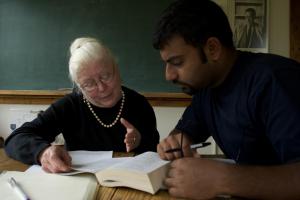 Nearly as senior as T. is Geraldine Pittman de Batlle, who joined Marlboro in 1969 after advanced graduate study at Southern Illinois University and Columbia University. Known for her passion for literature ranging from English Romantic poetry to modern fiction, Geri won the adoration of students who enjoyed working closely with her on projects of mutual interest.
Nearly as senior as T. is Geraldine Pittman de Batlle, who joined Marlboro in 1969 after advanced graduate study at Southern Illinois University and Columbia University. Known for her passion for literature ranging from English Romantic poetry to modern fiction, Geri won the adoration of students who enjoyed working closely with her on projects of mutual interest.
“Geri conveyed a love of literature that was infectious,” says Chris Davey ’93, a freelance editor who says he daily applies the skills she taught. “Her request that students show attentiveness to and respect for words struck me as profoundly ethical, as a call to bear witness to the power of words and the effects of that power, to recognize the ways great literature enacts empathy, and then to go beyond, to seek to hear for oneself ‘the grass grow and the squirrel’s heart beat,’ to brave ‘the roar which lies on the other side of silence.’”
“The amount of writing I had to do for Geri was intense,” says Ron Mwangaguhunga ’94, now a working writer and editor in New York City with a novel on the way. “Good or bad thoughts, Geri wanted me to get them on paper just to get in the practice of regular writing. Her patience, compassion, and, above all, demand for excellence—and always, always, more writing— helped me massively with the work I do today.”
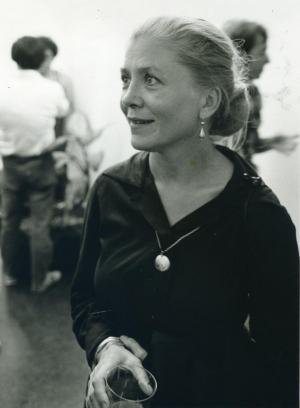 “I was always happy working with Geri,” says Sue Crimmins ’89, now a landscape designer. “I saw her every day, and we made each other smile. Even on those days that I had not finished even a paragraph of my Plan, she held me as closely as any member of her family. We would sit right down next to each other and plow through all the words and all the sentences and all the paragraphs, clarifying every idea. She was my teacher, but also a good friend, and my strictest tutor. I am still sorting my ideas, and words, and reaching for clarity in everything I do.”
“I was always happy working with Geri,” says Sue Crimmins ’89, now a landscape designer. “I saw her every day, and we made each other smile. Even on those days that I had not finished even a paragraph of my Plan, she held me as closely as any member of her family. We would sit right down next to each other and plow through all the words and all the sentences and all the paragraphs, clarifying every idea. She was my teacher, but also a good friend, and my strictest tutor. I am still sorting my ideas, and words, and reaching for clarity in everything I do.”
“Geri has tremendous respect and patience for literature,” says Ryan Stratton ’11, who works as an admissions counselor at Marlboro. “I think that one of the best lessons I learned from Geri was reverence—in a contemporary world where irony is used as social and intellectual capital, I think it was a humbling experience to really sit down and listen to what Dante was trying to say about self-growth and love for others. Geri had a reputation for being a tough teacher—I would say that she has only the highest expectations for her students, because she knows them and has faith in them, and wants them to reach their fullest potential.”
Music professor Stan Charkey, the Luis C. Batlle Chair in Music, has taught music at Marlboro since 1977, when he received his Master of Music degree from the University of Massachusetts. A composer and performer of note, Stan had premieres of new works performed in Paris, Los Angeles, Washington, and of course Marlboro.
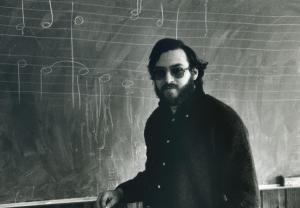 “I appreciated that Stan held his students to high standards, but always allowed us the space to pursue our interests independently,” says Allen Magana ’13, a graduate student in Latin American and Iberian studies at the University of California, Santa Barbara. “He respected us as scholars and never expected anything less from our work. Stan offered me the opportunity to prove to myself that I have the ability to complete top-level scholarship. This experience gave me the confidence to continue to pursue academic research, and I hope someday to foster this same love of scholarship in my own students.”
“I appreciated that Stan held his students to high standards, but always allowed us the space to pursue our interests independently,” says Allen Magana ’13, a graduate student in Latin American and Iberian studies at the University of California, Santa Barbara. “He respected us as scholars and never expected anything less from our work. Stan offered me the opportunity to prove to myself that I have the ability to complete top-level scholarship. This experience gave me the confidence to continue to pursue academic research, and I hope someday to foster this same love of scholarship in my own students.”
“My favorite part about working with Stan is that he was extremely open-minded to my ideas as a composer,” says Felix Jarrar ’16, already an accomplished composer and pianist in the New York area. “During my lessons with him, he would always give me constructive feedback on how my musical gestures would or wouldn’t work toward my larger musical goals. He had a lot of really great suggestions for pieces to listen to if I found myself ‘stuck.’ My work with Stan has helped me immensely since leaving Marlboro. When I write music, I use all of the contrapuntal and compositional skills he taught me.”
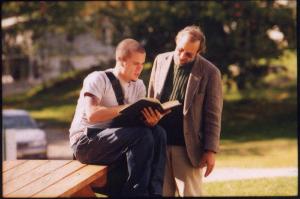 “Stan’s regard for a student was, for me, ideal,” says Peter Blanchette ’92, a musician, composer, and founder of the Happy Valley Guitar Orchestra. “He neither pampered you through the maddeningly tricky counterpoint exercises, nor disrespected your earnest effort. On the other hand, he would expose the weaknesses in your results with firmness, followed by excellent suggestions of how to improve. He taught me more about what makes great music tick than anyone else in my life, and every single day that I work, I apply musical understanding that he brought into my life.”
“Stan’s regard for a student was, for me, ideal,” says Peter Blanchette ’92, a musician, composer, and founder of the Happy Valley Guitar Orchestra. “He neither pampered you through the maddeningly tricky counterpoint exercises, nor disrespected your earnest effort. On the other hand, he would expose the weaknesses in your results with firmness, followed by excellent suggestions of how to improve. He taught me more about what makes great music tick than anyone else in my life, and every single day that I work, I apply musical understanding that he brought into my life.”
“He was always ready to put some beautifully intricate piece in front of us and have at it,” says Mike Harrist ’10, a professional musician and music teacher in Boston. “His joy in reading and playing is deep and infectious. Looking back, I’ve learned many lessons just from this one aspect of our time together. Joy in making music and a realistic perspective on one’s ability are not antithetical. Holding both together fuels improvement and leads to a grounded musicality. Stan’s teaching and high standards continue to inspire me to be a better musician and more rigorous thinker.”
One of Amanda DeBisschop’s fondest memories is when she joined T. Wilson to hear poet Gary Snyder, one of his mentors, and they approached Gary after the reading. When Gary said to T., “Shouldn’t you be close to retiring now?” Amanda piped in, “He can’t retire. I wouldn’t know what to do.”
All in the college community share Amanda’s sentiments about T., and feel just the same about Geri and Stan, but acknowledge that this is a shortsighted response. Amanda concurs: “I simply want every other Marlboro student to have access to the person who taught me the most valuable things that I know: to be a conscious part of a community, to write as though my life depends on it (and it does), and to do good work.”
Also of Note
Woodrow Wilson Fellow Marcia Grant (pictured right) was on campus for a week in October to engage in all things Marlboro, from attending Town Meeting to visiting classes both on Potash Hill and at the graduate campus. Marcia is currently provost of the American University in Paris, and has a distinguished career in global higher education, including serving in institutions in Africa, the Middle East, and South Asia. While at Marlboro she made presentations to the campus community on international careers, favorite books, and the global impact of liberal arts education.
In November, MA in Teaching with Technology student Jasmin Bey Cowin was elected president of the Rotary Club of New York #6, where she has been active for 10 years. Guided by her passion for “education as the tool for transformative empowerment and a pathway to a fulfilling life,” Jasmin will coordinate the club’s community, city, and international service projects. An accomplished educator herself, she holds both a master’s and doctorate in education from Teachers College at Columbia University.
In October, Stephanie Sopka joined the campus as technical services librarian. “I like getting to see all of the books that come in,” says Stephanie. She came to Marlboro from the University of Illinois at Urbana-Champaign, where she completed her MS in library and information science and worked in the university law library. “I have spent a lot of time studying feminist theory and queer theory, so I’m excited to expand our collection in these areas, and to support students and faculty in their work.”
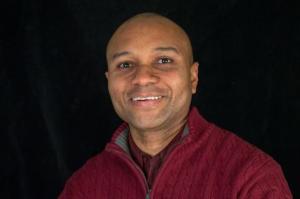 “There are those who have access to technology, but they don’t have the knowledge and skills to use this technology to support learning in school,” said Emmanual Ajanma (pictured right) during his Capstone presentation about bringing Google Apps to a school in Nigeria. Emmanual was one of 10 students in the MAT, MSM, and MBA programs who presented their Capstones in November. Other presenters included Dhruv Jagasia on developing a socially-conscious eyewear brand and Missy Munoz on promoting sustainable building standards for low-income housing. See an excerpt.
“There are those who have access to technology, but they don’t have the knowledge and skills to use this technology to support learning in school,” said Emmanual Ajanma (pictured right) during his Capstone presentation about bringing Google Apps to a school in Nigeria. Emmanual was one of 10 students in the MAT, MSM, and MBA programs who presented their Capstones in November. Other presenters included Dhruv Jagasia on developing a socially-conscious eyewear brand and Missy Munoz on promoting sustainable building standards for low-income housing. See an excerpt.
Marlboro College made the short list for “10 colleges where joining student clubs is easy” released in February by U.S. News and World Report. Drawn from U.S. News’ survey of more than 1,800 colleges and universities nationally, Marlboro is the only New England college in the top 10 and tied second with Hamilton College in New York State. Marlboro was rated as having 6.1 students per club, nine times the average among the 1,195 ranked schools that reported these data in an annual survey.
Sophomore Spencer Knickerbocker, student trails steward, was instrumental to the success of Trails Day 2016 in October, which drew 20 volunteers despite the cold, rainy weather. “I was pleasantly surprised by the great enthusiasm of volunteers and their willingness to work,” says Spencer, who spent four years training as a nordic skier and is delighted to discover Marlboro’s trails. “I have traveled around the world to the hotbeds of nordic sport, yet I never found a place with so many trail options as Marlboro.”
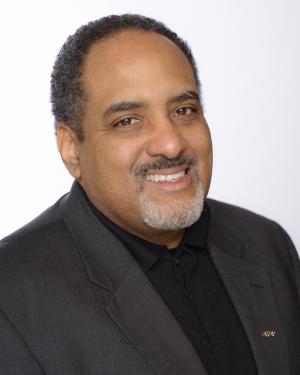 New graduate faculty member Kevin McQueen (pictured right) brings extensive experience in corporate finance, with a deep commitment to facilitating social change through mission-driven organizations. Marlboro College Graduate and Professional Studies was pleased to welcome Kevin and four other new faculty members recently, part of the ongoing development and enrichment of the management program. Kevin, Beth Tener, and Melinda Weekes-Laidlow joined Marlboro in the fall, each of them bringing new skills and expertise in corporate finance, collaborative leadership, and organizational development. This winter, Jude Smith Rachelle and Carol Stimmel joined the management faculty to co-teach an MBA seminar in Performance Measurement and Analytics. You can learn more about these new faculty members and their impressive backgrounds on the college website.
New graduate faculty member Kevin McQueen (pictured right) brings extensive experience in corporate finance, with a deep commitment to facilitating social change through mission-driven organizations. Marlboro College Graduate and Professional Studies was pleased to welcome Kevin and four other new faculty members recently, part of the ongoing development and enrichment of the management program. Kevin, Beth Tener, and Melinda Weekes-Laidlow joined Marlboro in the fall, each of them bringing new skills and expertise in corporate finance, collaborative leadership, and organizational development. This winter, Jude Smith Rachelle and Carol Stimmel joined the management faculty to co-teach an MBA seminar in Performance Measurement and Analytics. You can learn more about these new faculty members and their impressive backgrounds on the college website.
Last fall a team of undergraduate and graduate faculty, staff, and students made several visits to Ashoka Changemaker Campuses, including College of the Atlantic, College of Social Innovation, and Brown University. Along with a discussion at Town Meeting in September, these visits were important steps toward Marlboro College being recognized as a Changemaker Campus by Ashoka, a global organization that promotes positive change by supporting social innovation. “The team has been working hard over the last few months, and we’re eager to share our progress with you,” says Kelsa Summer ’13, a student in the MS in Management program. Learn more.
Community Spirit 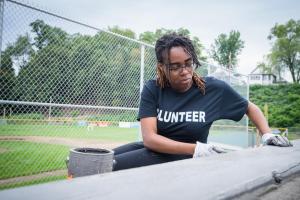 Freshman Cyane Thomas joined 14 other students, staff, and faculty in a United Way Day of Caring project, giving a fresh coat of paint to the local little league field, in September.
Freshman Cyane Thomas joined 14 other students, staff, and faculty in a United Way Day of Caring project, giving a fresh coat of paint to the local little league field, in September.
Most Important Meal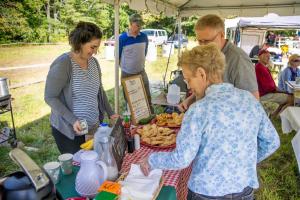 Junior Emily Motter and chemistry professor Todd Smith help serve up breakfast at the Marlboro Community Town Fair in September, raising money for the college farm.
Junior Emily Motter and chemistry professor Todd Smith help serve up breakfast at the Marlboro Community Town Fair in September, raising money for the college farm.
Getting Green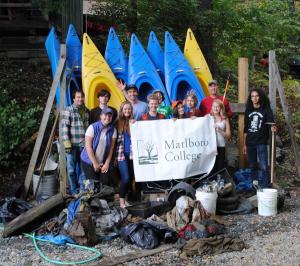 In October, members of the Environmental Studies Colloquium participated in a clean-up on the Connecticut River, finding many articles too gross to mention.
In October, members of the Environmental Studies Colloquium participated in a clean-up on the Connecticut River, finding many articles too gross to mention.
Learning to Spell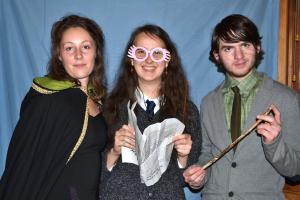 Senior Crystal Graybeal, junior Kristen Thompson, and sophomore Dan Medeiros strike a magical pose at the Hogwarts Dinner in October, which welcomed local families.
Senior Crystal Graybeal, junior Kristen Thompson, and sophomore Dan Medeiros strike a magical pose at the Hogwarts Dinner in October, which welcomed local families.
Events
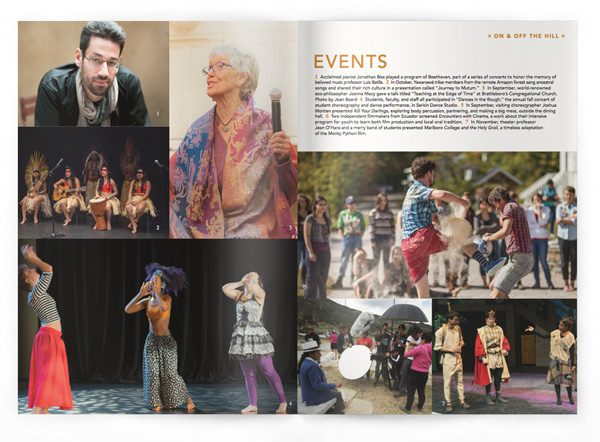
1 Acclaimed pianist Jonathan Biss played a program of Beethoven, part of a series of concerts to honor the memory of beloved music professor Luis Batlle. 2 In October, Yawanawá tribe members from the remote Amazon forest sang ancestral songs and shared their rich culture in a presentation called “Journey to Mutum.” 3 In September, world-renowned eco-philosopher Joanna Macy gave a talk titled “Teaching at the Edge of Time” at Brattleboro’s Congregational Church. Photo by Joan Beard 4 Students, faculty, and staff all participated in “Dances in the Rough,” the annual fall concert of student choreography and dance performance, in Serkin Dance Studio. 5 In September, visiting choreographer Joshua Monten presented Kill Your Darlings, exploring body percussion, partnering, and making a big mess, outside the dining hall. 6 Two independent filmmakers from Ecuador screened Encounters with Cinema, a work about their intensive program for youth to learn both film production and local oral tradition. 7 In November, theater professor Jean O’Hara and a merry band of students presented Marlboro College and the Holy Grail, a timeless adaptation of the Monty Python film.
Focus on Faculty
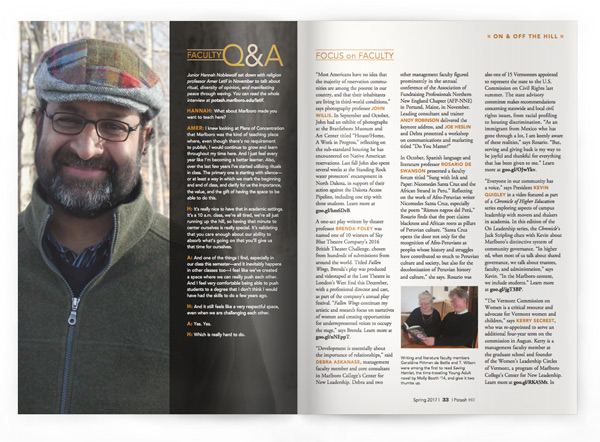
Faculty Q&A
Junior Hannah Noblewolf sat down with religion professor Amer Latif in November to talk about ritual, diversity of opinion, and manifesting peace through waving. You can read the whole interview.
Hannah: What about Marlboro made you want to teach here?
Amer: I knew looking at Plans of Concentration that Marlboro was the kind of teaching place where, even though there’s no requirement to publish, I would continue to grow and learn throughout my time here. And I just feel every year like I’m becoming a better learner. Also, over the last few years I’ve started utilizing rituals in class. The primary one is starting with silence— or at least a way in which we mark the beginning and end of class, and clarify for us the importance, the value, and the gift of having the space to be able to do this.
H: It’s really nice to have that in academic settings. It’s a 10 a.m. class, we’re all tired, we’re all just running up the hill, so having that minute to center ourselves is really special. It’s validating that you care enough about our ability to absorb what’s going on that you’ll give us that time for ourselves.
A: And one of the things I find, especially in our class this semester—and it inevitably happens in other classes too—I feel like we’ve created a space where we can really push each other. And I feel very comfortable being able to push students to a degree that I don’t think I would have had the skills to do a few years ago.
H: And it still feels like a very respectful space, even when we are challenging each other.
A: Yes. Yes.
H: Which is really hard to do. “
Focus on Faculty
Most Americans have no idea that the majority of reservation communities are among the poorest in our country, and that their inhabitants are living in third-world conditions,” says photography professor John Willis. In September and October, John had an exhibit of photographs at the Brattleboro Museum and Art Center titled “House/Home, A Work in Progress,” reflecting on the sub-standard housing he has encountered on Native American reservations. Last fall John also spent several weeks at the Standing Rock water protectors’ encampment in North Dakota, in support of their action against the Dakota Access Pipeline, including one trip with three students. Learn more.
A one-act play written by theater professor Brenda Foley was named one of 10 winners of Sky Blue Theatre Company’s 2016 British Theater Challenge, chosen from hundreds of submissions from around the world. Titled Fallen Wings, Brenda’s play was produced and videotaped at the Lost Theatre in London’s West End this December, with a professional director and cast, as part of the company’s annual play festival. “Fallen Wings continues my artistic and research focus on narratives of women and creating opportunities for underrepresented voices to occupy the stage,” says Brenda. Learn more.
“Development is essentially about the importance of relationships,” said Debra Askanase, management faculty member and core consultant in Marlboro College’s Center for New Leadership. Debra and two other management faculty figured prominently in the annual conference of the Association of Fundraising Professionals Northern New England Chapter (AFP-NNE) in Portand, Maine, in November. Leading consultant and trainer Andy Robinson delivered the keynote address, and Joe Heslin and Debra presented a workshop on communications and marketing titled “Do You Matter?”
In October, Spanish language and literature professor Rosario de Swanson presented a faculty forum titled “Sung with Ink and Paper: Nicomedes Santa Cruz and the African Strand in Peru.” Reflecting on the work of Afro-Peruvian writer Nicomedes Santa Cruz, especially the poem “Ritmos negros del Per.,” Rosario finds that the poet claims blackness and African roots as pillars of Peruvian culture. “Santa Cruz opens the door not only for the recognition of Afro-Peruvians as peoples whose history and struggles have contributed so much to Peruvian culture and society, but also for the decolonization of Peruvian history and culture,” she says. Rosario was also one of 15 Vermonters appointed to represent the state to the U.S. Commission on Civil Rights last summer. The state advisory committee makes recommendations concerning statewide and local civil rights issues, from racial profiling to housing discrimination. “As an immigrant from Mexico who has gone through a lot, I am keenly aware of these realities,” says Rosario. “But, serving and giving back is my way to be joyful and thankful for everything that has been given to me.” Learn more.
“Everyone in our community has a voice,” says President Kevin Quigley in a video featured as part of a Chronicle of Higher Education series exploring aspects of campus leadership with movers and shakers in academia. In this edition of the On Leadership series, the Chronicle’s Jack Stripling chats with Kevin about Marlboro’s distinctive system of community governance. “In higher ed, when most of us talk about shared governance, we talk about trustees, faculty, and administration,” says Kevin. “In the Marlboro context, we include students.” Learn more.
“The Vermont Commission on Women is a critical resource and advocate for Vermont women and children,” says Kerry Secrest, who was re-appointed to serve an additional four-year term on the commission in August. Kerry is a management faculty member at the graduate school and founder of the Women’s Leadership Circles of Vermont, a program of Marlboro College’s Center for New Leadership. Learn more. In January the college had a book release party for Kerry’s chapter in the new book Leading and Managing in the Social Sector, published by Springer International. Co-written with Marla Solomon, director of partnership programs for Five Colleges, the chapter is an analysis of the Women’s Leadership Circles of Vermont.
“The workshop table can feel like Thanksgiving with somebody else’s family, which welcomes you but laughs at jokes you don’t understand,” says writing professor John Sheehy. In January, John published an article in The Chronicle of Higher Education titled “Taking the Fight to the Page,” describing his experiences teaching the summer writing intensive that brings veterans and civilians together to write. “Between Hemingway and James we, soldiers and civilians, try to make truth out of stories, which are all we have to make it out of. We have things in common. We have all loved, we have all lost brothers, sisters—albeit some violently and far too young.”
In November, ceramics professor Roberto Lugo was one of 46 artists from across the U.S. to receive an unrestricted $50,000 fellowship from United States Artists. “This will significantly impact my work,” said Rob, who has received national attention for his work combining visual arts traditions and stimulating new conversations around cultural tolerance. “I will be able to create a new body of work and have the financial ability to work on aspects that were previously unavailable.” Learn more. Rob was also featured in Remezcla, in a profile by Michelle Threadgold ’07, and in a series of podcasts from craftschools.us.
Oxford Classics Fellow Isabella Grunberger-Kirsh presented a faculty forum in October titled “Ausonius the Loser: A Gaulish Poet on the Brink,” referring to the forgotten fourth-century poet of Bordeaux. While Ausonius’s oeuvre consists of self-pitying verses composed by a failed politician at the edge of the decaying Roman Empire, Ella’s talk aimed to restore some of the poet’s authorial dignity. “I explore the possibility that Ausonius knew precisely what he was doing in reinventing himself as a provincial loser,” she says. “His refusal to comment openly on the afflicted empire offers us an opportunity to view the fall of the Roman Empire from a fresh angle.”
In October, philosophy professor William Edelglass was elected to the board of directors of the International Association of Environmental Philosophy. His recent invited talks include “What Counts as Philosophy? Rationality and Practice in Buddhist Traditions” (Brooklyn College); “The Practice of Place: From Pilgrimage to Cosmopolitanism” (The Sitka Institute); “sKu rten: Painting and Sculpture as Religious Technologies in Tibetan Buddhism” (Barre Center for Buddhist Studies); and “Why the Bodhisattva Isn’t Satisfied: Buddhism, Happiness, and Ethics” (Smith College). Among other recent publications, William has a chapter on “Mindfulness and Moral Transformation: Awakening to Others in Śāntideva’s Ethics” in The Bloomsbury Handbook of Indian Ethics. He also continues to teach regularly at the Barre Center for Buddhist Studies in Barre, Massachusetts.
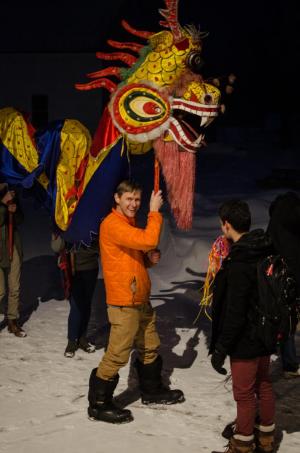 In October and November, art history professor Felicity Ratté presented a series of lectures at the Osher Lifelong Learning Institute in Dummerston, Vermont, on the art and architecture of the Islamic world. Titled “What Is Islamic Art?” and examining everything from the five pillars of Islam to modern adaptations of Islamic art, the series was designed as a way for non-Muslims to learn about Islamic culture and history.
In October and November, art history professor Felicity Ratté presented a series of lectures at the Osher Lifelong Learning Institute in Dummerston, Vermont, on the art and architecture of the Islamic world. Titled “What Is Islamic Art?” and examining everything from the five pillars of Islam to modern adaptations of Islamic art, the series was designed as a way for non-Muslims to learn about Islamic culture and history.
In November, art faculty members Tim Segar and Cathy Osman participated in a group exhibition at A.P.E. Gallery Northampton, Massachusetts, titled “Forget What I Said.” Also featuring the work of William Brayton, Brenda Garand, Carol Keller, Joe Smith, Deborra Stewart-Pettengill, and Erica Wurtz, artists who have known each other for many years, the show provided the opportunity to create a visual dialogue across the disciplines of collage, painting, and sculpture.
In June, history professor Adam Franklin-Lyons gave an invited talk at the Vermont Midsummer Medieval Summit at Norwich University, titled “Political Information and Communication in the Crown of Aragon: Collaboration & Control.” “By late in the 14th century, the kingdom of Valencia was woven together by a dense web of ambassadors and runners who could move information between cities and courts at surprising speed,” says Adam. “The level of formalized communication allowed for new practices of information dissemination, collaboration, and secrecy at multiple levels of government.”
Caleb Clark, faculty member and chair of the MA in Teaching with Technology program was chosen to participate in the Vermont Leadership Institute class of 2017. A program created by the Snelling Center for Government, VLI seeks out, honors, challenges, and develops a select group of Vermont citizens each year who have the potential to provide the leadership needed to address issues of statewide significance. Caleb is one of 24 fellows selected this year on the basis of their professional achievements, demonstrated interest in the community, and capacity for leadership.
In November, visiting French language professor Frederique Marty presented a faculty forum titled “Translation and Religious Propaganda in Renaissance Europe.” Frederique explored how the vernacular was used by the Jesuits to counter the rise of Protestantism, specifically to diffuse the story of the Virgin of Loreto and carve a space for Marian devotion in Europe and the New World. She argued that although Jesuit authors such as Orazio Torsellini in Italy and Louis Richeome in France have taken all the credit, the role of the anonymous translator cannot be underestimated.
Alumni News

Arts and Culture Beat
Ten years after graduating from Marlboro with a Plan in film and political theory, Michelle Threadgould ’07 is a successful journalist covering the intersection between the arts, culture, and social justice.
“I have always been a collaborative storyteller,” says Michelle Threadgould, a freelance journalist and content marketing manager living in Oakland, California. “I love that arts-and-culture journalism introduces me to artists who are creating subversive work and finding a way to creatively voice resistance.”
Michelle’s path to writing success has not been a straightforward one—she graduated just before the national recession of 2008, when jobs in any field were scarce and jobs for a punk-rock political writer were nonexistent. Along the way she has been a maitre d’, a costume designer for feature films, a magazine intern, a food editor at Gotham Digest, and an executive assistant. In 2011 she applied her costume-designing skills to jewelry design and opened a “rock n’ roll reclaimed jewelry” business.
“I became part of an arts collective, shared a showroom, and eventually opened up a store with five other designers. I believed in my business, I believed in my designs, and I opened up pop-up shops across the country, sold at craft fairs, and poured my energy into making it work. But I learned that without enough capital to invest in it, my business wasn’t sustainable.”
A couple of years ago Michelle wrote a story and submitted it to a contest judged by Ben Fong-Torres, the legendary editor of Rolling Stone and a personal idol of hers. Fong-Torres selected her to read her work at a “Basement Series” event, and buoyed by his faith in her she started to pitch stories to outlets regularly. She also began freelancing as a copywriter. She applied for a music editor position at a local alt weekly in the Bay Area, and the managing editor assigned Michelle her first big feature in eight years. The rest is history.
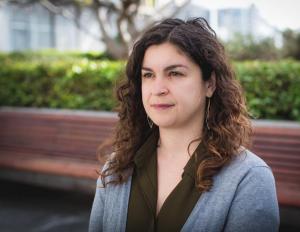 Last year, Michelle’s piece in the Observer, called “We’re Not Going Anywhere: Growing up Latino and Punk in America,” went viral. She was contacted by several national publications, and started writing more regularly for national audiences. In September she had a feature in Remezcla about Marlboro ceramics professor Roberto Lugo, “the self-proclaimed ‘ghetto potter’ turning classical ceramics into radical art.” After a couple of years writing about the Bay Area, she has become close to all the local music and art editors. She writes for the San Francisco NPR affiliate, KQED, on a monthly basis.
Last year, Michelle’s piece in the Observer, called “We’re Not Going Anywhere: Growing up Latino and Punk in America,” went viral. She was contacted by several national publications, and started writing more regularly for national audiences. In September she had a feature in Remezcla about Marlboro ceramics professor Roberto Lugo, “the self-proclaimed ‘ghetto potter’ turning classical ceramics into radical art.” After a couple of years writing about the Bay Area, she has become close to all the local music and art editors. She writes for the San Francisco NPR affiliate, KQED, on a monthly basis.
“For Día de Los Muertos last year, I went to Mexico City and worked on my first piece of international, investigative journalism,” says Michelle. “I also sold several pieces related to the vibrant alternative rock music scene there. It was an incredible experience.” She plans to move to Mexico next spring to cover more Latinx (the gender-neutral alternative to Latino) issues. “I never had the luxury of traveling before last year, but now it’s really important to me to travel across Latin America.”
Reflecting on her college years, Michelle says, “I think that Marlboro helped me become an even more critical thinker. The teachers at Marlboro pushed me to be a better writer and not be complacent. Also, two of my best friends are from Marlboro, Amanda Martin (’08) and Laura Baetscher (’07), and we have all become politically minded and committed to our work. Their support has been incredible.”
To learn more about Michelle, go to clippings.me/mthreadgould.
Class notes are listed by year and include both graduates and nongraduates; the latter are listed under the class with which they are associated.
’51
“It has been 65 years since I graduated from Marlboro, and a lot has happened during those years,” says BOB HICKEY. “It all started with my draft notice for induction into the Army a few days before graduation. I eventually became an officer but never received orders for Korea. Soon after my release from the service I enrolled in the Columbia Graduate School of Business, and I received my master’s degree in 1956. I immediately went to work for GE and held numerous positions in six different plants prior to moving to Oklahoma City in 1962 where I met my future wife, Joyce. We had two children and decided to raise them in Oklahoma. I subsequently held several management positions with GE, Honeywell, and other companies. I was also able to become involved in community affairs, including the Chamber of Commerce, Travelers Aid, the United Way, and other causes. In 1996 we attended the alumni reunion and enjoyed visiting with some of my old classmates. I just wish we were in a position to attend some of the subsequent reunions. This year I celebrated my 25th year of retirement, during which I have continued a pretty active life. I continued for some time teaching in the Graduate School of Business at Oklahoma City University. We have also traveled extensively through the United States and Europe. We feel fortunate to have lived long and fulfilling lives.”
“Joan and I have kept up a busy pace of life over the years,” says CHARLES STAPLES. “My hiking abilities for rugged terrain are not what they used to be, but I still enjoy all l can of nature and the outdoors. Our cultural pursuits in Chicago continue, including classical music concerts and the Chicago Art Institute, my alma mater. I continue to volunteer as a docent at the Chicago Cultural Center, whose building I helped to save when the political powers wanted to tear it down. As former precinct workers for the Independent Voters of Illinois, we are dismayed by the prospect of a Trump presidency, and are deciding how we can advance a more progressive agenda. We have used our travels this year to visit friends and family on both east and west coasts, and to enjoy our beloved White Mountains and the different, but dramatic, Rocky Mountains. While doing this, we have attended music festivals, including Marlboro and the Bach Festivals in Winter Park, Florida, and North Conway, New Hampshire. We were able to meet new Marlboro president, Kevin Quigley, and applaud the expansion of an excellent liberal arts experience to more students outside New England, as well as the integration of the graduate offerings into the rest of the college. Yeah for small liberal arts colleges!”
A Generation of Regeneration: Richard Liversage ’51
“People at Marlboro were very fine; I made a good choice,” says Richard Liversage, a Marlboro “pioneer” who studied biology and chemistry with John MacArthur, Sr., and roomed with renowned ecologist Robert MacArthur. Although he officially retired in 1991 after 44 years at University of Toronto’s Department of Cell and Systems Biology, Richard is still writing research papers on his life’s work: amphibian limb regeneration.
“The Swiss biologist Oscar Schotte, my professor at Amherst College where I got my master’s, was interested in exploring whether humans could regenerate limbs, like salamanders,” says Richard. “He wanted to be the first.” Richard did his doctorate at Princeton University under Elmer Butler, another pioneer in the field, on the subject of limb regeneration in larval newts. “When it comes to regeneration, it turns out, nothing works quite like amphibians.”
After Princeton, Richard moved to University of Toronto where they promised to support his continued research program. He taught some undergraduate courses in his first years there, but by the time he was a full professor he was primarily doing research and advising graduate students, many of whom were co-authors of his more than 80 published papers.
I’ve been on the go for quite some time,” says Richard, 92, whose research has spanned a period of incredible growth in the biological sciences. His most recent paper deals with the specific role of a hormone called insulin-like growth factor in appendage regeneration. “Only recently have we been able to look inside the regenerating limb, at the nerve structures and endocrine hormones that influence new growth.”
’65
In January, JAVED CHAUDHRI offered a series of talks in Brattleboro’s River Garden, co-sponsored by Windham World Affairs Council, titled “Islam and Muslims.” Topics included explaining the faith of Islam and what it means to be a Muslim, how a spiritual and social movement morphed into a culture and civilization as it spread across the globe, and the resurgence of Muslim societies in the modern age. A longtime resident of Brattleboro, Javed teaches at Keene State College.
’68
“Spent a few days at PAUL WILLARD’S Farm in Harvard, Massachusetts,” says MARK KLIMO. “Good to see my old roommate and Tim Mayo FS67, who came down from Brattleboro. Always good memories of Marlboro.”
’71
THOMAS TUCKER says, “Visited Fred Gray, saw Veronica Brelsford (professor emeritus), spent time at the college last fall. Felt good to be back in Vermont. Retired from Cathin Gabel School in 2015 after 37 years of teaching woodworking.”
’72
“The last few years have had lots of travel,” says HAROLD ZAKON. “My wife, Lynne, and I spent quality time at the University of Cambridge in the UK and in Munich. Academics is not a bad life. Greetings from ‘Franko.’ Hope life is good for you.”
’73 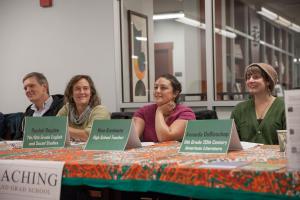 In September and October, DAVID HOLZAPFEL ’72 and MICHELLE CHASSE HOLZAPFEL had a joint show at Mitchell-Giddings Fine Arts, in Brattleboro, titled “Passaggi.” It included works in wood and multimedia, and featured an artists’ talk on October 8.
In September and October, DAVID HOLZAPFEL ’72 and MICHELLE CHASSE HOLZAPFEL had a joint show at Mitchell-Giddings Fine Arts, in Brattleboro, titled “Passaggi.” It included works in wood and multimedia, and featured an artists’ talk on October 8.
“Louis Moyse…is one of the most famous musicians you’ve likely never heard,” writes JIM LOWE in a September editorial in the Times Argus, referring to his former teacher and one of the founders of the music program at Marlboro College. “One of a handful of musicians who made Vermont a Mecca for music, this French-born flutist, pianist, conductor and composer last performed here in 1976.” Virtually no commercial recordings of Louis were available until now: a seven-CD set archived and mastered by Jim himself and released by Lyrichord Classical.
BOB DAUGHTRY says, “Artists never die, they just get older, and older...” In July, Bob presented a retrospective of his work in the Whittemore Theater Lobby, including a range of his paintings, drawings, and sculptures created over the years. A student at Marlboro from 1969 to 1971, he has been doing art ever since, and sometimes taking additional classes at Marlboro.
’75
DOUGLAS SMITH reports, “Our children are now all doing well and establishing their lives (or sometimes not). The company we formed (Plymouth Grating Laboratory) is growing and I was able to just step down from the busy job of being president to work on more technical things. We saw ELLEN SCHON last year at a talk at the Fuller Craft Museum and we still keep in contact with our friends in Vermont.”
In October, ALONZO LAMONT, JR. performed his latest play, B-Side Man, at The Tank in New York City. Alonzo is a playwright who’s had his work produced in D.C., Los Angeles, Atlanta, Houston, New York, and Amsterdam. He’s written for network TV, won grants, gotten awards, and been on the big stage, the little stage, and all points in-between. Find out more at zulufits.com.
’76
MELISSA ABRAMS says, “There are several classmates and friends that I would love to hear from, if any of you receive Potash Hill. Please write to 3819 Harbor Walk Lane, Fort Collins, CO 80525 or email missyabrams@aol.com.”
“I had a heart attack this fall and am grateful to be alive,” says JIM NEWELL. “I’m still raising my two sons, Adam (18) and David (going on 14). I’m not ready to leave them. We live in Wisconsin, near Milwaukee. I find myself thinking of Marlboro often.”
’79
“I am very contentedly ensconced in an office in the old Austine School—a lovely old ship of a building—amid the personnel of the UVM Extension,” says REBECCA BARTLETT. “I am part of the administrative apparatus supporting a variety of program staff and faculty in many fields related to farms, food, and community. My office window looks west, uphill toward the pine forest and the sunset. I am learning all kinds of new skills and enjoy being among these dedicated people.”
INEZ MCDERMOTT says, “This is my 17th year teaching art history at New England College in Henniker, New Hampshire, a small liberal arts college that isn’t quite as quirky as Marlboro—but enough so to keep me happy and challenged. I’ve also returned to the place I began my professional career and have co-curated an exhibition called ‘Mount Washington: The Crown of New England’ for the Currier Museum of Art in Manchester. It’s a look at the intersection of science, art, and tourism on New England’s highest peak. I’ve been living in Concord, New Hampshire, for the past 30 years, happily married for just as long, and the mother of two kids grown and gone—one a beer salesman, the other a stand-up comedian. Go figure.”
’82“I’m still teaching at SUNY-Plattsburgh— approaching 30 years,” says SAMUEL WOODWORTH NORTHSHIELD. “I see Tom Ragle once or twice a year, and see Joe Mazur’s name a lot—usually plugging a book.”
ABBY JACOBSON says, “I have been hired recently as the program coordinator for Putney Cares in Putney, Vermont, a small yet active organization which helps local seniors age in place. I help coordinate Meals on Wheels for seniors who are unable to shop or cook for themselves, I help coordinate rides to medical appointments and also to help schedule the many activities that happen within the Putney Cares Activity Barn. When I’m not at Putney Cares, I can be found at Hidden Springs Maple, selling local maple syrup and scooping ice cream at their small yet busy retail store. Would love to see any alumni who are passing through Putney.”
’86
ELIZABETH STEARNS SIMS says, “Joel—my husband for 15 years—and I have moved a bit following my jobs back and forth across the country, and finally landed back west where we both want to be. University of Montana continues to experience its challenges, but I continue to love what I do. Moving to Montana has brought us closer to our foster daughter, and I am a ‘grandmother’ of three great little boys and a soon-to-be little girl—and I’m proud to say her name will be Elizabeth. I am thankful (most of the time) for Facebook, as it has allowed me to reconnect, no matter how peripherally, with friends from the past.”
’90
In September, KIMBERLY WOODBURY joined the science department at St. Johnsbury Academy as a chemistry teacher. Most recently she worked as a chemistry teacher at the Winchendon School in Winchendon, Massachusetts. Kim holds an MAR from the Berkeley Divinity School at Yale University and a PhD in chemical ecology from Cornell University.
'91
CJ CHURCHILL completed his training in psychoanalysis this May at the Contemporary Freudian Society. He also became a Fellow of the International Psychoanalytical Society and a Fellow of the College of the International Journal of Psychoanalysis. He has a practice in psychotherapy and psychoanalysis in midtown Manhattan, www.christianjchurchill.com (next to the NY Public Library), and continues as professor of sociology at St. Thomas Aquinas College. He recently published his article “ ‘Is That All There Is?’: Time, Guilt, and Melancholia in Sleep No More and Macbeth” in the International Journal of Applied Psychoanalytic Studies.
’93
“Greetings from Southern California (still) and (sometimes) Marlboro,” says JESSICA O’PRAY. “Matthew and I are delighted that our daughter Emily chose Marlboro College for herself. She’s a member of the Class of 2020 and is absolutely loving Marlboro, her new community, and her classes. We are so happy to have reconnected with many of our own Marlboro friends when we visited campus in October for the simultaneous Parents Visit Day and Alumni Weekend—and look forward to doing it over and over again.”
“My oath did not include running into a gunfight, but it did include protecting the community,” said Vermont State’s Attorney SCOTT WILLIAMS, who was awarded the Carnegie Medal for civilian heroism in November. Scott was nationally recognized because of the heroic measures he took the day that social worker Lara Sobel was fatally shot in the parking lot of the state office building in Barre, Vermont, in August 2015. Learn more.
Sharing a Passion for Marlboro: Hongping Tian ’94
When Hongping Tian graduated from Marlboro with a Plan of Concentration in molecular evolutionary genetics, she could scarcely imagine that she would be back more than 20 years later to support the college as a trustee. With a breadth of international experience, including relevant international programs in higher education, Hongping brings valuable perspective to the board.
“I have great appreciation for Marlboro, both what it stands for in the educational landscape and the worldview that the Marlboro community shares,” says Hongping, who is director of international strategy and development for Harvard Graduate School of Arts and Sciences. “I am getting to know a group of people who are all dedicated to Marlboro, and I am thrilled to be among people who share my passion for the college.”
Hongping acquired her doctorate at Harvard Medical School and an MPH from Harvard School of Public Health, where she researched community health financing in rural China. She has worked for the CDC’s Global AIDS program in Beijing, and more recently as the director of health programs for the Yale-China Association. She now develops programs at Harvard in support of its global outreach work and cultivates key relationships with the school’s alumni, foundations, and institutions around the world.
“My experience at Marlboro transformed me and helped me to develop into the person I am today,” says Hongping. “I hope that Marlboro continues to nurture generations of students, and it is with this in mind that I feel deeply honored to have the opportunity to serve Marlboro in the capacity of trustee.”
’95
“Edward and I think often of Marlboro these days as our oldest, Avellana, is in her second year there,” says CAROLYN ROSS.“It has been a wonderful experience for her. Our other two children are 15 and 17 right now. Time flies. We are happy to see any Marlboro friends who happen to come to Salem.”
“I’m excited about my new job,” says ERIK PEARSON. “Starting in November, I will be the senior virtual reality engineer at EMD Serono, the U.S. biotech division of Merck in Darmstadt, Germany. I will lead an innovation team creating VR experiences for the company’s international divisions that specialize in liquid crystal technologies, biotechnology, pharmaceuticals, and other emerging industries. While the company and role is global, I’ll be based in downtown Austin.”
’97  JENNY KARSTAD says she and JODI CLARK ’95 are “still enjoying life at ‘GreenLeaf Knoll’ and working hard at our life’s passions. Stop by if you are in town.”
JENNY KARSTAD says she and JODI CLARK ’95 are “still enjoying life at ‘GreenLeaf Knoll’ and working hard at our life’s passions. Stop by if you are in town.”
AARON TIEGER says, “Still happily relocated to Shelburne Falls, where I have a small private psychotherapy practice (aarontieger.com), in addition to working full-time for a community health center serving the hill towns of Western Massachusetts. I haven’t been writing much poetry for the past few years, though my newest book, Chaos Flowers, is due out by the end of this year from Skysill Press. In my spare time I have been focusing on playing guitar, both solo under the name Errant Tiger (find me on Bandcamp, Soundcloud, and/or Facebook), and with my wife, Rachel, as the band Catbasket (find us on Facebook). I’d love to hear from anyone I’m not already in touch with, particularly if you’re local and/or interested in psychotherapy and/or weird acoustic music.”
’02
In September, TIM COLLINS performed The Bystander, his one-man show addressing sexual-assault prevention, at the Root Social Justice Center in Brattleboro to benefit the Women’s Freedom Center. “I went to college at Marlboro and started writing one-man shows in college, and started touring when I was still a student,” he says in a Brattleboro Reformer article on the event. “I graduated in 2002 and I’ve been touring ever since.” Learn more.
’03
“I’m happy to be back in New England after spending six years in Nova Scotia,” says JONATHAN FRANKLIN. “I finished up my PhD at Dalhousie University in 2015, and am now starting my second year as a postdoctoral fellow at Harvard University, researching new methods of monitoring urban greenhouse gas emissions.”
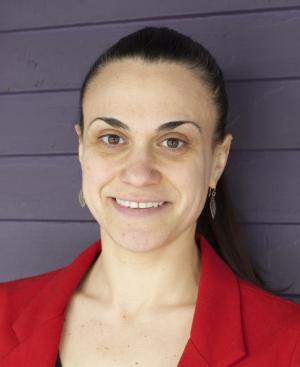 “I’ve been enjoying being at home in Vermont for a little while before heading back out west,” says JANET ANDERSON. “I’ve been in Washington and Alaska for the last few years, working for the US Forest Service, and have come to think that almost any problem can be solved by spending more time outside. I’ll be back in Washington in January, close enough to civilization that I might actually get to hang out with the Marlboroites out there. Take care of yourselves and each other, read good books, and play in the snow.”
“I’ve been enjoying being at home in Vermont for a little while before heading back out west,” says JANET ANDERSON. “I’ve been in Washington and Alaska for the last few years, working for the US Forest Service, and have come to think that almost any problem can be solved by spending more time outside. I’ll be back in Washington in January, close enough to civilization that I might actually get to hang out with the Marlboroites out there. Take care of yourselves and each other, read good books, and play in the snow.”
’04
“Excited to hopefully visit the Hill this spring and see freshman Isy Zuniga, who grew up in the church I currently serve,” says QUINCY WORTHINGTON. “It’s hard to believe that it’s been almost 12 years since I was at Marlboro. So much has changed for me, I can’t imagine what Marlboro is like now. I think about how much Marlboro has influenced who I am today as a pastor, a father of four amazing and creative kids, and as a person. I miss smoking cigarettes and swearing with John Sheehy.”
“I identify as an artist first, which is great in this line of work,” says CULLEN SCHNEIDER in an article in the Weekly Packet of Blue Hill, Maine. Cullen is owner of the Fairwinds Florist in Blue Hill, named the best florist shop in Maine by Down East Magazine last year. Cullen was also inducted into the American Institute of Floral Designers in July, a ceremony she calls “pretty cool.”
’05
“Last September, I was ordained as a minister in the American Baptist church,” says JONATHAN ELSENSOHN. “One of my closest friends, CHIP HURD ’03, was there to introduce me to the assembly as well as to deliver the Charge to the Congregation (both of which he did with his characteristic wit). ELIOT GOODWIN ’04 and CHARLIE ISRAEL ’05 both came down to help me celebrate. I also took a position as the senior pastor of the First Baptist Church of Freehold, New Jersey.”
’10
MORGAN INGALLS reports, “JOHN DUNHAM ’05 and I got married in September!”
’11
“As of this year, my amazing partner and I have reached one of our longtime goals and opened a pastry shop in Salem, Oregon,” says JONATHAN JONES. “It’s a big ol’ forest green truck, and I wouldn’t have life any other way. We get to enjoy the nature that we moved to Oregon to experience, make our own hours, and generally enjoy this short life. We have plans for a brick-and-mortar expansion in the next few years, so if any of you other fine people want to financially support a fellow alum I certainly wouldn’t say no.”
’12
“I’m working as a paralegal and doing freelance writing and editing in New York City,” says JACK ROSSITER-MUNLEY. “I also produce a couple poetry podcasts and am the host of a foreign policy podcast, putting my cultural history and international relations study at Marlboro to good use.”
Expanding Representation in Theater: Mercedes Lake ’12
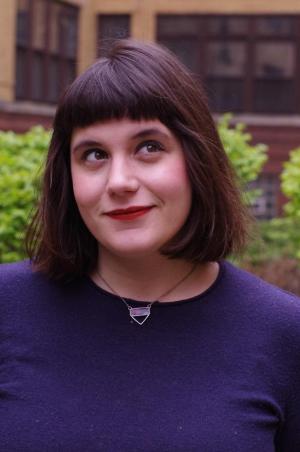 “Plays should be a conversation—not a lecture,” says Mercedes Lake, whose play Taught premiered at the John Cullum Theater in New York in October (see Giving in Action, Winter 2016). “My education at Marlboro taught me that it is more valuable to ask questions than to prescribe answers. This undoubtedly made me a better playwright.”
“Plays should be a conversation—not a lecture,” says Mercedes Lake, whose play Taught premiered at the John Cullum Theater in New York in October (see Giving in Action, Winter 2016). “My education at Marlboro taught me that it is more valuable to ask questions than to prescribe answers. This undoubtedly made me a better playwright.”
Mercedes graduated from Northwestern University’s Writing for the Screen and Stage MFA program in June 2016, and her plays have received readings at the Chicago Dramatists and been finalists in the Brooklyn-based Scrap Mettle reading series. Her New York production of Taught was made possible by a competitive grant from the Araca Project, an initiative by the Araca Group to foster young arts entrepreneurs.
“I pitched Taught against a dozen other possible plays,” says Mercedes. “I emphasized that popular culture is a lens through which we can dramatize American ideology, a lesson I learned from Kate Ratcliff and Brenda Foley. The judges loved it.”
Mercedes is interested in connecting historical moments to present phenomena in her plays, and in expanding representation in theater and television. With Taught, a play about weight loss, reality television, capitalism, and the dangers of defining “health,” she wanted to make fatness visible without being confrontational.
“Even in the progressive art spheres, fat people—mainly fat women—are a punchline, if they’re represented at all. By writing a play where fatness and shame are at the forefront of the conversation, I wanted to make it impossible for people to disengage.”
’13
“In spring 2017 I will be starting a master’s in public policy management at USM’s Muskie School,” says MADELYN HOLM. “I am also leaving my current position at the food bank to pursue a sexual health educator job.”
In August, JESSE NESSER’S film Walk With Me: The Trials of Damon J. Keith was featured opening night of the Middlebury New Filmmakers Festival. The film tells the remarkable story of 94-year-old, still-serving federal judge Damon Keith, who presided over some of the most important civil rights cases of the last century. Judge Keith travelled to Middlebury and appeared on stage afterwards for discussion.
JOSHUA PETERSEN has been continuing his career as a production designer and director in film and television in New York, where he still lives, as well as in LA, Berlin, and Tokyo. “One film that I’ve art directed, Crown Heights, was accepted into the 2017 dramatic competition lineup at Sundance in January (my second in two years!), as well as a film that I was both producer and production designer for, Boogeyman Pop,” he says. “I’m looking to submit Apprehending Edmund Montrell, a short film that I helmed as director, to the Slamdance Short Film Festival that commences in Park City the same time as Sundance in Park City—really trying to go 3/3 in Utah this year.” Learn more at jpetersenfilm.com.
’14 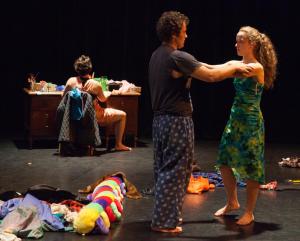 “I moved into Boston this winter to start my graduate program at University of Massachusetts Boston, studying for a master’s in English,” says MOLLY BOOTH. “I’m currently finishing up my second YA Shakespeare book, Nothing Happened, with Disney Hyperion publishing, and I have a few other secret book projects in the works. I’ve also been volunteer directing for All the World’s a Stage Players, a homeschool Shakespeare theater group in Chelmsford, Massachusetts, and our production of Twelfth Night will go up at the end of March. Lately I’ve really recommitted to my love of Shakespeare, and I’m in such dorky love with the work.” See a November article about Molly in The Boston Globe.
“I moved into Boston this winter to start my graduate program at University of Massachusetts Boston, studying for a master’s in English,” says MOLLY BOOTH. “I’m currently finishing up my second YA Shakespeare book, Nothing Happened, with Disney Hyperion publishing, and I have a few other secret book projects in the works. I’ve also been volunteer directing for All the World’s a Stage Players, a homeschool Shakespeare theater group in Chelmsford, Massachusetts, and our production of Twelfth Night will go up at the end of March. Lately I’ve really recommitted to my love of Shakespeare, and I’m in such dorky love with the work.” See a November article about Molly in The Boston Globe.
’16
In December, FELIX JARRAR premiered a new piece created on commission for violinist Brendan Speltz and cellist Andrew Janss, the musicians who performed in his opera The Fall of the House of Usher. Titled Mosaic of Myself: A Walt Whitman Experience, the new work was inspired by the tragic shooting at the Pulse nightclub in Orlando, Florida, and was performed in the crypt of New York’s Church of the Intercession. All proceeds for the event, which included other musical activities and a DJ set, went toward GLAAD to support the LGBTQA+ community.
Graduate and Professional Studies
Management
’06
“Well, still at the same perch, IT Help Desk at Dartmouth,” says GREG PHILLIPS MSM. “There is never a dull day, and very intriguing people to work with each day. And, I found the woman of my dreams. Susie and I have been together now almost three years, living and loving in Concord, New Hampshire, and traveling all over. Off to Thailand in October and back over the pond for winter break. Enjoying life to the full.”
’10
“Carolyn and I have a son, Julian, who is four and loves to swim, cook, garden, and fly to Ganymede,” says JONATHAN CROWLEY MBA. I’ve been working as a major gifts officer for the last four years at Northfield Mount Hermon School, an independent boarding school with a long history of diversity and social justice; a working farm with strong sustainability programming; and a budding mindfulness program. We are moving from Charlemont to Shelburne to be nearer to the Vipassana Meditation Center where we continue to teach courses.”
DAVID YOUNG MSM says, “I’ve been working as the project development manager for Power Guru, Southern Vermont’s premier solar electric system design and integration company, for almost two years. I’ve still got my hands in residential design projects as they come along, specializing in a whole-systems design approach for net-zero energy efficiency, passive house standards, and a permaculture philosophy for natural habitat restoration and building site integration.”
’11
“I recently passed my two-year anniversary as Cheshire County Grants Manager,” says SUZANNE BANSLEY MBA. “My success in this position is highlighted by a $4 million grant that was awarded last week by the Substance Abuse and Mental Health Services Administration to align children’s mental health services. It’s surprising how I use my MBA every day in the work that I do to convene stakeholders, discuss critical community projects, strategize solutions, and seek funding to implement solutions. Most importantly, I’m really happy doing what I’ve always wanted to be doing: improving my community.”
’14
“I continue to participate actively in the Women’s Leadership Circles follow-up group, which has now been meeting for five months,” says JANE NESBITT MDO. “It’s provided a trusting, engaging, and enjoyable setting for ongoing learning and support both on a professional and a personal level, and I relish the relationships that are developed and nurtured.”
’15
“I started in July as the new associate dean and director of the Inclusion, Diversity, Equity, Access, Social Justice (IDEAS) Center at Allegheny College, in Meadville, Pennsylvania,” says JUSTIN ADKINS MDO. “This job has taken me away from my beloved Western Mass, but it is a good move and I am thriving here. I am currently living in a first-year student resident hall with my dear cats Kropotkin and Indigo, as we wait to move into our new little craftsman-style home half a mile from campus and have the fabulous black lab Subcomandante Marcos join us.”
Teaching
’11
ANNE KOPLINKA-LOEHR MATS and her partner, Max Bregan, purchased a house this summer in Brattleboro, and are now engaged. Anne is still teaching seventh/ eighth-grade social studies at Brattleboro Area Middle School, and Max is an aircraft mechanic for Gulfstream.
“In August I started my EdD in learning analytics in higher education, with a focus on quantitative design and measurement, at Northcentral University,” says LISA WHALEN, MSIT/MAT. “I’m currently working at Waters Corporation in Milford, Massachusetts, as a senior instructional designer. No new marriages or births, but I did have a rather exciting trip to the Learning Solutions Conference back in March for the eLearning Guild, where I was a speaker for multiple events, including my session ‘Bite-Sized Learning is the New Black.’”
’12 ADAM PROVOST MAT has been promoted to director of the Burlington, Vermont, Technical Center.
’14 BECCA POLK, LAUREN PERLSTEIN, NINA KUNIMOTO ’11, MARESA NIELSON ’13, ANNEKE DUNNINGTON ’15, and COREY SORENSEN ’15, all graduates from the MA in Teaching for Social Justice program, were joined by faculty member Mikaela Simms in creating Indigo Radio, a weekly radio show on Brattleboro’s community radio station. The show seeks to deepen understanding and make connections through engaging others in the local community and throughout the world. Topics tackled so far include the Oaxaca teachers’ resistance, privatization and charter schools, standardized testing, the Black Lives Matter movement, and the Standing Rock water protectors action. Tune in Sunday at noon at WVEW 107.7, or learn more at facebook.com/indigoradiowvew.
’15
LARA NEELEY MATESOL was recently selected to be an English Language Fellow through the U.S. Department of State, a prestigious opportunity limited to highly qualified U.S. educators in the field of TESOL. “Becoming a fellow was a dream of mine ever since becoming an English as a Foreign Language teacher over eight years ago, and even more so after enrolling in the MATESOL program at Marlboro,” says Lara. “I feel that is truly where the process for becoming a fellow began.” Lara’s 10-month fellowship is located in Hyderabad, India, at the Siasat Daily, an Urdu newspaper that aims to promote local literacy, including offering free English language classes for disadvantaged communities.
CORY SORENSEN MATS is now teaching fourth grade at Guilford Central School.
Technology
’06
“I’ve just started my new position as the principal of The Dover School,” says MATT MARTYN MSIT. “I’m looking forward to working with staff, students, and families to spread the wealth of technology wonders I gathered while attending the Marlboro Grad School.”
’07
“I will be teaching a website development course at Community College of Vermont in Rutland this fall semester,” says RONALD PULCER MSIE. “I’m also helping my church, Grace Congregational Church, toward replacing their legacy website with a WordPress site, and improving their workflows and communication by using WP as a content management system. This summer I participated in the Rutland Mini Maker Faire, where I presented a Python Turtle drawing app, in which multiple turtles can be “remotely” controlled from the smartphones of visitors of Maker Faire. It reminded me of doing my MSIE Capstone.”
Former Faculty and Staff
In October and November, retired sociology professor JERRY LEVY presented a series of lectures at the Osher Lifelong Learning Institute, in Dummerston, Vermont. Titled “Humanism and Progress,” Jerry’s lectures consider the impact of “humanistic communities” on the enduring problems of poverty, war, and ecological degradation.
KEN SCHNECK, former dean of students, was the recipient of an Excellence in Journalism Award from NLGJA, the national association of LGBTQ journalists. An associate professor at Baldwin Wallace University and director of the Leadership in Higher Education graduate program, Ken won first place for excellence in podcasts for producing and hosting This Show is So Gay, a nationally syndicated podcast creating unique dialogue around LGBTQ topics. Learn more.
In Memoriam
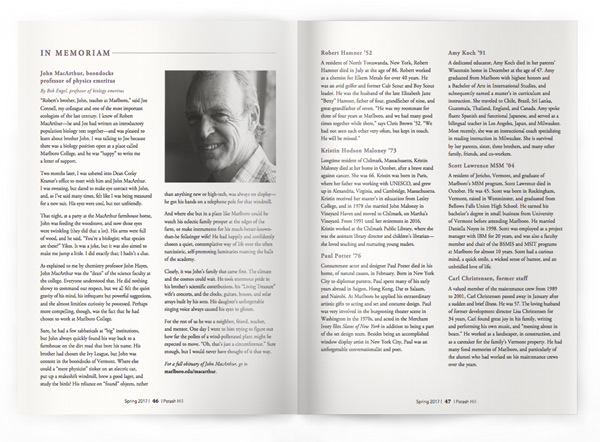
John MacArthur, boondocks professor of physics emeritus
By Bob Engel, professor of biology emeritus
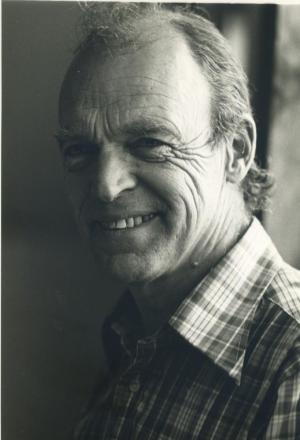 “Robert’s brother, John, teaches at Marlboro,” said Joe Connell, my colleague and one of the most important ecologists of the last century. I knew of Robert MacArthur—he and Joe had written an introductory population biology text together—and was pleased to learn about brother John. I was talking to Joe because there was a biology position open at a place called Marlboro College, and he was “happy” to write me a letter of support.
“Robert’s brother, John, teaches at Marlboro,” said Joe Connell, my colleague and one of the most important ecologists of the last century. I knew of Robert MacArthur—he and Joe had written an introductory population biology text together—and was pleased to learn about brother John. I was talking to Joe because there was a biology position open at a place called Marlboro College, and he was “happy” to write me a letter of support.
Two months later, I was ushered into Dean Corky Kramer’s office to meet with him and John MacArthur. I was sweating, but dared to make eye contact with John, and, as I’ve said many times, felt like I was being measured for a new suit. His eyes were cool, but not unfriendly.
That night, at a party at the MacArthur farmhouse home, John was feeding the woodstove, and now those eyes were twinkling (they did that a lot). His arms were full of wood, and he said, “You’re a biologist; what species are these?” Yikes. It was a joke, but it was also aimed to make me jump a little. I did exactly that; I hadn’t a clue.
As explained to me by chemistry professor John Hayes, John MacArthur was the “dean” of the science faculty at the college. Everyone understood that. He did nothing showy to command our respect, but we all felt the quiet gravity of his mind, his infrequent but powerful suggestions, and the almost limitless curiosity he possessed. Perhaps more compelling, though, was the fact that he had chosen to work at Marlboro College.
Sure, he had a few sabbaticals at “big” institutions, but John always quickly found his way back to a farmhouse on the dirt road that bore his name. His brother had chosen the Ivy League, but John was content in the boondocks of Vermont. Where else could a “mere physicist” tinker on an electric car, put up a makeshift windmill, brew a good lager, and study the birds? His reliance on “found” objects, rather than anything new or high-tech, was always on display— he got his hands on a telephone pole for that windmill.
And where else but in a place like Marlboro could he watch his eclectic family prosper at the edges of the farm, or make instruments for his much-better-knownthan- he folksinger wife? He had happily and confidently chosen a quiet, contemplative way of life over the often narcissistic, self-promoting luminaries roaming the halls of the academy.
Clearly, it was John’s family that came first. The climate and the cosmos could wait. He took enormous pride in his brother’s scientific contributions, his “Living Treasure” wife’s concerts, and the clocks, guitars, houses, and solar arrays built by his sons. His daughter’s unforgettable singing voice always caused his eyes to glisten.
For the rest of us he was a neighbor, friend, teacher, and mentor. One day I went to him trying to figure out how far the pollen of a wind-pollenated plant might be expected to move. “Oh, that’s just a circumference.” Sure enough, but I would never have thought of it that way.
See a full obituary of John MacArthur.
Robert Hamner ’52
A resident of North Tonawanda, New York, Robert Hamner died in July at the age of 86. Robert worked as a chemist for Elkem Metals for over 40 years. He was an avid golfer and former Cub Scout and Boy Scout leader. He was the husband of the late Elizabeth Jane “Betty” Hamner, father of four, grandfather of nine, and great-grandfather of seven. “He was my roommate for three of four years at Marlboro, and we had many good times together while there,” says Chris Brown ’52. “We had not seen each other very often, but kept in touch. He will be missed.”
Kristin Hodson Maloney ’73
Longtime resident of Chilmark, Massachusetts, Kristin Maloney died at her home in October, after a brave stand against cancer. She was 66. Kristin was born in Paris, where her father was working with UNESCO, and grew up in Alexandria, Virginia, and Cambridge, Massachusetts. Kristin received her master’s in education from Lesley College, and in 1978 she married John Maloney in Vineyard Haven and moved to Chilmark, on Martha’s Vineyard. From 1991 until her retirement in 2016, Kristin worked at the Chilmark Public Library, where she was the assistant library director and children’s librarian— she loved teaching and nurturing young readers.
Paul Potter ’76
Consummate actor and designer Paul Potter died in his home, of natural causes, in February. Born in New York City to diplomat parents, Paul spent many of his early years abroad in Saigon, Hong Kong, Dar es Salaam, and Nairobi. At Marlboro he applied his extraordinary artistic gifts to acting and set and costume design. Paul was very involved in the burgeoning theater scene in Washington in the 1970s, and acted in the Merchant Ivory film Slaves of New York in addition to being a part of the set design team. Besides being an accomplished window display artist in New York City, Paul was an unforgettable conversationalist and poet.
Amy Koch ’91
A dedicated educator, Amy Koch died in her parents’ Wisconsin home in December at the age of 47. Amy graduated from Marlboro with highest honors and a Bachelor of Arts in International Studies, and subsequently earned a master’s in curriculum and instruction. She traveled to Chile, Brazil, Sri Lanka, Guatemala, Thailand, England, and Canada. Amy spoke fluent Spanish and functional Japanese, and served as a bilingual teacher in Los Angeles, Japan, and Milwaukee. Most recently, she was an instructional coach specializing in reading instruction in Milwaukee. She is survived by her parents, sister, three brothers, and many other family, friends, and co-workers.
Scott Lawrence MSM ’04
A resident of Jericho, Vermont, and graduate of Marlboro’s MSM program, Scott Lawrence died in October. He was 45. Scott was born in Rockingham, Vermont, raised in Westminster, and graduated from Bellows Falls Union High School. He earned his bachelor’s degree in small business from University of Vermont before attending Marlboro. He married Daniella Noyes in 1998. Scott was employed as a project manager with IBM for 20 years, and was also a faculty member and chair of the BSMIS and MSIT programs at Marlboro for almost 10 years. Scott had a curious mind, a quick smile, a wicked sense of humor, and an unbridled love of life.
Carl Christensen, former staff
A valued member of the maintenance crew from 1989 to 2001, Carl Christensen passed away in January after a sudden and brief illness. He was 57. The loving husband of former development director Lisa Christensen for 34 years, Carl found great joy in his family, writing and performing his own music, and “messing about in boats.” He worked as a landscaper, in construction, and as a caretaker for the family’s Vermont property. He had many fond memories of Marlboro, and particularly of the alumni who had worked on his maintenance crews over the years.
Magnanimity Cum Laude
Flushed with Pride
When the Marlboro Gardens dorm (pictured right) was scheduled for renovation to house student interest groups, alumni parents Jim and Joyce Lande had one very basic question: “What about plumbing?” The parents of Josh Lande ’08, Jim and Joyce were pleased to learn that the renovation would indeed include bathrooms, and supported the effort with a generous contribution. Remarkably, it is the third bathroom upgrade on campus they have cheerfully sponsored over the years.
“When we went up for Josh’s graduation, he lamented that the school was spending money on stuff that looked good, instead of plumbing,” says Jim, referring to a fancy new door in the campus center. “He described plumbing as a continuing problem.” When the college renovated Howland in 2011, Jim and Joyce eagerly offered to help fund bathroom improvements (Marlboro Record, Fall 2011).
“The school was very nice to put up a plaque in the renovated bathroom in honor of my son,” says Jim, a retired economist who now likes to “fool with anything that makes noise or a mess.” Last year he and Joyce helped support renovations to the bathroom in the campus center, commemorated with another plaque. “One good thing leads to another, and we have now been able to support three projects that include an element of bathroom renovation.”
Josh Lande studied physics and computer science at Marlboro, with a Plan of Concentration that included the creation of software to analyze X-ray diffraction data. According to his parents, Josh applied to Marlboro because he wanted to be responsible for his own education. He went on to get his doctorate in astrophysics from Stanford, and now works as a data scientist at Twitter.
Incidentally, Josh’s grandfather was Ellsworth Mason, who taught English literature at Marlboro in the early 1950s. These were very lean years for the college, and Ellsworth once wrote a letter describing some of the hardships (Potash Hill, Summer 2001). But he added, “The students I had at Marlboro were better than those I had taught for two years at Williams. Just as bright and more motivated.” He did not mention the plumbing, but his family is confident that Ellsworth, who died in 2013, would approve of the renovations.
Potash Hill Society
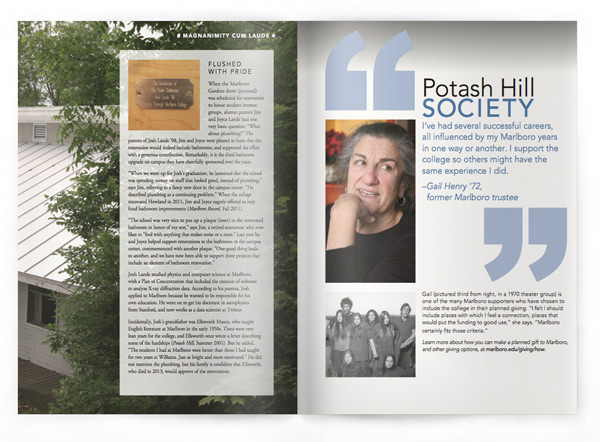
I’ve had several successful careers, all influenced by my Marlboro years in one way or another. I support the college so others might have the same experience I did.
–Gail Henry
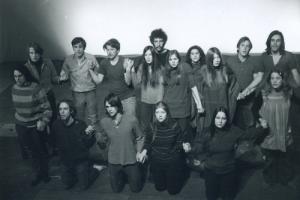 Gail (pictured fourth from right, in a 1970 theater group) is one of the many Marlboro supporters who have chosen to include the college in their planned giving. “I felt I should include places with which I feel a connection, places that would put the funding to good use,” she says. “Marlboro certainly fits those criteria.” Learn more about how you can make a planned gift to Marlboro, and other giving options, at marlboro.edu/giving/how.
Gail (pictured fourth from right, in a 1970 theater group) is one of the many Marlboro supporters who have chosen to include the college in their planned giving. “I felt I should include places with which I feel a connection, places that would put the funding to good use,” she says. “Marlboro certainly fits those criteria.” Learn more about how you can make a planned gift to Marlboro, and other giving options, at marlboro.edu/giving/how.
Special Web Features
To Live in Two Worlds: An interview with Amer Latif
Senior Hannah Noblewolf sat down with religion professor Amer Latif in November to talk about ritual, diversity of opinion, and manifesting peace through waving. If you are like Hannah, or most people, you could listen to Amer talk all day.
Hannah Noblewolf: So what class has been the most enjoyable for you to teach this semester?
Amer Latif: Ah, well you know the answer to that one (laughing) because you’re in it. It’s our class, To Live in Two Worlds: Ritual and the Power of Imagination. You know, it’s been an interest of mine that I’ve been thinking about for a while—a few years—and wanting to get to the place to teach it. With Nelli (Sargsyan, anthropology professor) being here now, it was great timing, so we’re team-teaching it. The goal is to have an overview of how ritual has been studied, but I want to really get at the importance of imagination in the performance of ritual. The second text has been the highlight so far.
HN: Yeah, it’s definitely the class favorite.
AL: Yeah, it’s remarkable. It’s called Ritual and Its Consequences: An Essay on the Limits of Sincerity, and it takes this idea of ritual as an act of imagination, and keeps developing it, right? The authors are able to connect what might have seemed completely different and un-relatable fields.
HN: It’s very interdisciplinary—what kind of students are taking it?
AL: They come from all over. Like, we have students who are studying linguistics, anthropology students, lots of first-year students who are just there for the interest in it. But, one of the things that is key in this text, and the question that I had wanted to explore, which I think I’ve gotten really good material on as a result of reading and as a result of our conversations, is how is it we are able to create forms that allow us to navigate a certain dissatisfaction, a lack of perfection in life. So the title of the course is “To Live In Two Worlds,” one is the world of our experience, where things are broken. We look around and things are always, constantly needing attention, falling out of harmony, and we’re trying to keep things together. And then there’s a world that we create in ritual settings where the rules are clear, things come together and a certain order is created. And usually we leave those places of ritual feeling renewed, right?
HN: Yes.
AL: We are renewed whether the ritual is “secular” or the ritual is something associated with some kind of organized religion. And what this book does, which is really important for me, is to actually take away those binaries we have been straddling, in the West, of the religious versus the secular. To really look at the human level, the human being and how it is that there are certain needs that we have, certain realities that we are confronted with, and certain capacities that we have, across cultures, with which to deal with what we are confronting. This book really brings it down to that basic level that allows, for my taste, for us to go beyond disciplinary boundaries, boundaries that are of our own creation like religion versus the sciences—we did not know this binary until a few hundred years ago. The vast majority of the human race has never known that kind of a separation. The authors of Ritual and Its Consequences take up the old religious debate between ritual and sincerity as it developed within Judaism and turn these into two possible orientations towards the world and the self. The ritual orientation or mode views the correct performance of actions as the key element of being religious, whereas the sincere mode emphasizes the intention and feeling behind the performance of ritual. Too much emphasis on ritual can lead to ritualism while too much emphasis on sincerity can lead to puritanism. The book is pointing out, ultimately, that there is no purely ritual and no purely sincere space. There’s always an interaction between the two, no matter what domain we think we are in because it’s a human reality. It’s two aspects of the way in which we relate to the world. But in all of human history, the modern era is characterized by an exclusive and really unprecedented emphasis on sincerity.
HN: M-hmmm.
AL: For the consequences of sincerity, the authors give the example of some of the Puritan divines—the Puritans who founded this country—if you look at their writings, they are trying to get at this sense of, this core of the self. They are trying to constantly analyze their selves, you know? And the authors are pointing out that there is no end to it, because the deeper you dig, the more you will find, and there’s never an ending point. That’s one way of understanding why the self-analytical writings of these Puritan Divines are so voluminous. Whereas, the ritual mode is exemplified in an old Jewish adage about performing ritual, “It’s just like brushing your teeth, just do it! You just have to do it!” There has been this idea that we are doing it, we are in sync with it, our mind, our heart, our everything is in sync. So there are certain problems that arise from an overemphasis on either of these two poles. And the sincere one leads us to Puritanism, which is a form that tries to separate things and is constantly trying to keep itself clean, and has problems with ambiguity, contradiction. Whereas the purpose of ritual, in some ways, and this is what the authors are arguing, is that ritual allows us to create space in which we can hold ambiguity and contradiction. It allows for a capacity to be able to hold ambiguity, and ambiguity is that which characterizes life. So the sincere mode is very uncomfortable with that, it wants things to be clear, clean, simple. It wants the answer. So that’s the big question that they’re dealing with. As you can hear from me, it’s really, really exciting and the authors bring in all kinds of material. They bring in studies of play because what they’re saying is that ritual, like play, creates “as-if” worlds. A subjunctive world, where together, you create the rules and enter into it. Within the chaos, or within the uncertainty, you clarify certain things, enter into it, and then you move out. It allows us the capacity to cross boundaries and, in doing so, ritual is a way in which we learn how to empathize, which is all about crossing perceived boundaries of self and other. So they associate ritual with playfulness, with empathy, and argue that the way forward for us as a culture, because we have lost certain of these capacities, is the creation of rituals.
HN: Are you doing any research right now that you’re particularly excited about?
AL: Yes, I am. It’s an ongoing project. I gave a talk this fall at Landmark College called “Only God Is Good”—which is a quotation from the gospels: “Islam Through the Words of Jesus.” So I take a story which is present in three Gospels: Mark, Matthew, and Luke, and use that as a way to talk about Islamic teachings and show the clear and profound connections between Islamic and Christian teachings. And I’m finding that people are, perhaps because of the past year and the rise in the hateful rhetoric that’s around them, people are really responsive and grateful. So I’m working on a book on the subject. There are a few other projects that I have going on as well, but this one has taken a new level of importance.
HN: You like writing?
AL: Yeah, I really appreciate being at Marlboro. The idea of clear writing is something that I’ve found really, really helpful. And it was one of the reasons why I came to Marlboro. Clear writing for me means being able to speak in a language that is decipherable and free of jargon so people can understand what we mean.
HN: There’s a huge issue with accessibility in language, especially in academia.
AL: Yes, that can be a problem. But I consider myself lucky in this respect because I speak regularly in the community and find myself in places where the audience is mixed, like at Landmark College there were lots of community members, friends and neighbors. And this Sunday I was invited at a church to talk about connections between Islam and Christianity. What I have found most helpful is to tell stories and, even in the book about Islam and Christianity, what I’m really doing is finding a story from the gospels in order to help folks move from something that they’re familiar with to something that seems different, and is the Other. That’s very meaningful for me and I feel grateful to be able to do something concrete, so that’s pretty exciting.
HN: And very timely too. What things about Marlboro made you want to teach here?
AL: First of all it’s the small size. And you know I lived in Vermont in between undergraduate and graduate school, so I knew the area and I wanted to end up here. My wife is from Vermont. Specifically, what I loved about Marlboro was the small size, the Clear Writing Requirement, and the Plan. You know, as a former science student who became interested in religion and philosophy, I think the distinctions between fields are important, at one level, but in many ways arbitrary. So a person has to bring all of this together so that you can see beyond distinctions. Marlboro possesses this quality just by its intentional small size. You know I’m in the science building, and some people are surprised by that but I’m at home here, you know?
HN: Also nicer offices.
AL: Well, I’ve given up the opportunity to move offices, so I’ve been here 13 years and I feel quite comfortable and happy here. I like the light in the Science building. Going back to what made me want to come here, the Clear Writing Requirement—and the Plan as well but clear writing really is crucial—it is an institutionalized test of comprehension. If you can’t say it in clear words, simple words, then you don’t really know it in the way that you think you do. I think it is one of the most important civic value as well. I feel that in pushing clear writing, we’re really doing a service for the world and for our society to help people to speak clearly, to think clearly, to use writing as a way to understand things and then communicate that in a way that allows you to connect with your neighbor. So that’s really Marlboro’s emphasis, on those two things.
HN: Clear Writing and Plan?
AL: Yes, I knew looking at Plans of Concentration that Marlboro was the kind of teaching place where, even though there’s no requirement to publish, I would continue to grow and learn throughout my time here. And I just feel that every year I’m becoming a better learner. I’m learning newer things and being able to share them with students. Every year I find myself more excited about Marlboro and what I’m able to do in the classroom. Like the structure of our class together: there’s this academic overview, then there’s this book Ritual and Its Consequences and we’re ending with a novel, Ceremony, which brings us back into the space of imagination and allows us to think of others. So that’s an ideal course for me—that combines the theoretical with the literary—and where else would you do that? Also, over the last few years I’ve started utilizing rituals in class. The primary one is starting with silence—or at least a way in which we mark the beginning and end of class, and clarify for ourselves the importance, the value, and the gift of having the space to be able to explore ideas together.
HN: It’s really nice to have that in academic, but also community settings. Because I’ve had other experience with that kind of mindfulness but having it in a community setting, but also it's a 10 a.m. class, we’re all tired, we’re all just running up the hill, so having that minute to center ourselves is really special. It’s validating that you care enough about our ability to absorb what’s going on that you’ll give us that minute and we can center ourselves.
AL: And one of the things I find, especially in our class this semester, and it inevitably happens in other classes too, I feel like we’ve created a space where we can really push each other. And I feel very comfortable being able to push students to a degree that I don’t think I would have had the skills to do a few years ago.
HN: And it still feels like a very respectful space, even when we are challenging each other.
AL: Yes. Yes.
HN: Which is really hard to do.
AL: Yeah. By starting in silence, by making an intention to practice qualities of patience, courage, and compassion, I feel that we set up a shared space together. The vigorous conversations and disagreements are then held within a container that is larger than those disagreements because we have already started by acknowledging and acting upon shared values. We can hold the differences. So I thought that was very helpful, especially once the election happened. And even prior to the election, when there was a difficult conversation, like with what happened in Town Meeting with the Inclusion and Diversity statement. We had a full class devoted to discussing and processing the perspectives and feelings that came up in that Town Meeting using the tools and the concepts that we’ve been working on.
HN: And the trust that we had built.
AL: Yes, and then after the election it was really great. To acknowledge peoples’ vulnerability, fragility, the rawness some people were feeling, and to do something about that but also to really push and say “this is the demand of reason now.” To say that if you’re feeling fear, how to work with that and to recognize that part of it is true—it is true for you that you are feeling afraid—but also to know how much less you need to be worried about things as well. Don’t let fear take over. That was a real highlight for me, how we were able to acknowledge the many dimensions of ourselves. And that is a goal for me in teaching and as a human being. Feelings are real, we should not deny them. But reason is real too, and you should not do away with what its demands are. Again, it’s like the movement between ritual and sincerity; we have these faculties and they have to work together. If the fear that we’re feeling is so overwhelming or overpowering that our minds stop working, it’s a problem. At that point we need to use reason to work back from it. But if in our mind we say, wishfully thinking, “oh, don’t worry about it,” reason has to come in to say “but look, there’s some stuff you do need to be careful about”.
HN: They need to work together. You can’t be entirely intellect and reason or entirely emotion. But a lot of teachers might say, you know, check your emotions at the door.
AL: That’s it. That’s part of the reason that I thought Marlboro would be a place where I could do this. For me it’s about the whole person. But that wasn’t the path for me in science, where I had to check my emotions at the door and I saw what it did to me. And I realized its shortcomings. So since that day it has been recovering that for myself.
HN: You’re a recovering scientist.
AL: (Laughs) I think there are plenty of scientists who are totally whole. It was a certain kind of scientism that I bought into. It was an ideological, almost colonial, oppressive, tyrannical understanding that science has all the answers. “This is hard science and this is what is real.” So, to see where it led me and then to work back from that and find out that there are multiple levels of reality, and just because you can’t measure something doesn’t mean it’s not real, but at the same time it demands our attention and is a huge part of our being. Neither ought to displace the other.
HN: You mentioned you’ve been here for 13 years. What are your hopes for the future of the school and the future of the community?
AL: My hope is that we are able to maintain this style of education at Marlboro, which I know that everybody here is committed to, the trustees are committed to. There is something important and extremely crucial about our size. Qualities are lost when you get to certain thresholds. There’s a certain place where quantity changes quality. So that’s something I would want to maintain. And something that I hope that we can develop more of: well, I think that with this election there has really been—in the last few years I’ve become more aware of it, and perhaps it’s because I’ve grown myself as a person, as a thinker—a certain dissatisfaction with some of the rhetoric that the left is using. While I sympathize with all those causes, I feel like as a school we ought to be able to offer more diversity of ideas, you know?
HN: And different opinions?
AL: Yeah, so I hope we can develop and work hard at being a community that is able to take differences seriously at all levels, and I think differences of ideas are very important. I do not want us to turn into an ideological place. I feel like part of the work for an educational institution is not just following what society is doing but setting an example for society. So Marlboro, by its small size and tightknit sense of community and the close relationships between staff and faculty and students—for me there is no distinction, we are all here working on the same things—we can offer models of how it is that we can open a space, keep open a space, where everyone feels they have a say and the debate can take place without people being shut down. I think we’re a very left-leaning place; I don’t want us to become stuck in that. I want us to be open because I think we need to model that for the country. So we need to produce students who are able, and we ourselves as teachers need to be able, to hold those differences within themselves.
HN: With a larger college, you would have more diversity and people with more diverse opinions, perhaps.
AL: Yeah but at the same time, you would lose that ability to have that close sense of community. So, how do we do that? That’s one of the questions. Like in class, if everyone is of the same opinion the professors play that role, in some ways. I find myself taking on that role a bit more. Even if I don’t agree with something I’ll still bring it out and ask students to respond to a contrary position. I’m not simply there to reinforce opinions, but to challenge peoples’ understandings. But we need to do that as a community. It is healthier. It’s easier to assume that everybody thinks the same as we do.
HN: And you can almost do that here.
AL: It’s easy to do it here. That makes a safe and easy place, but I think that that’s part of our challenge for the future. My hope is that we are a place that doesn’t become ideological. Not that we are, by definition, but just because a certain number of people think the same way. It can happen, but part of our work is to keep challenging ourselves, to keep waking ourselves up. So that’s currently a hope, but that’s a hope for the whole country (laughs). And I see our classes as being a part of that. It comes down to me, that I have to be open enough.
I’ve found myself, since the election, actually crossing boundaries more than I usually do. Just thinking and making a conscious effort to say “hi” to people. Especially in public places. I had a really neat interaction with a hunter, at a gas station. I was gassing up and I saw this guy coming out of the gas station, he had a little tag in his hand, and he was walking towards his truck, behind which there was a trailer. And I looked carefully trailer, and saw that there was something on the trailer—it was a deer. So I just walked over, you know, and said “hi” and asked him a few questions about it, and I don’t think I would have done it a week ago. That was, for me, a significant thing to reach out and acknowledge the fact that this guy had just hunted this deer. And I found out about him that he’d been going out for a whole week, he’d taken time off of work, and now that he’d hunted this deer he was all set for his meat. You know, I wished him well, and wished him that he enjoyed the meat, and he had a slight smile on his face which I thought was really great.
HN: Do you feel like since the election, or in general recently, people respond to you differently?
AL: I don’t know. Perhaps. At this church that I went to, at the end lots of people came up to say hello and one of the ladies, an older lady, she shook my hand and said something about the talk I’d given then came close to me, whispering in my ears, “If they start coming for you, you let me know.” And I feel like, I think it was more of a problem for me after 9/11 than it is now. I think I’m older, perhaps, also I think I’m very sheltered. I don’t really bear the brunt of it. I don’t really feel that, because I feel like Donald Trump has been such an equal opportunity vilifier.
HN: We’re all going to hell!
AL: But even there I feel like, you know, what President Obama is saying now is really the way to go. He’s saying how we should hold him to his better statements, rather than the terrible things he’s said. That we should hold him accountable to what he said when he was accepting the victory, you know. But this is what we learn from ritual, that ritual is work—it’s endless work.
HN: Endless work.
AL: Endless work, yeah.
HN: It’s not like reason—it doesn’t have an end.
AL: You have to keep doing it over and over. Some of this crossing of boundary, just being with folks with whom we disagree, and finding some kind of common ground—even if it’s a wave—I feel it’s really important. And a wave, as a ritual, is actually very, very significant. This was one of the things that people at the church found most significant. I was talking about Islam, and Jesus, and Mary, and the Quran, and what it was like growing up for me as a Muslim in Pakistan and what we were taught about Jesus and how much Muslims love Jesus. Muslims, compared to certain branches of Christianity, are actually more Christian than Christians.
HN: That’s funny
AL: It is! I mean, we believe in Jesus. The Quran has him speaking from his cradle and one of the most poignant parts of the Qur’anic description is when the Holy Spirit is brought into Mary’s womb. How scared she is to see Gabriel appearing, and what happens at the time of delivery, how ashamed she is. Anyway, so there’s beautiful and arresting imagery in the Qur’an, and the tradition about Jesus and Mary. You know, he is an Islamic prophet, a beloved one. So I shared a lot of this stuff, but in the end this church was a community that’s a whole range of folks, from very conservative to very progressive, NPR-listening folks. And the pastor there told me that, and I tried to speak to this aspect of finding common ground. And it was based in some of the stories in the gospels— but I’m talking about even just at the level of the wave—to explain Islam, because Islam means making peace. It’s usually translated as submission but what have you done by submitting? You’ve made peace. So really there’s two beings encountering each other and one bows its head and hence peace is made, so two wills become one. So it’s making peace, rather than warring with God, you’ve made peace with God and hence become a Muslim. And one of the things I really, I loved about Vermont and I don’t think I would be able to articulate it quite this way when I came here in ’94, but, just the waving.
HN: Yeah, everybody does it.
AL: Right? I love it. And I think we realize the significance of the wave if we just bring the other hand up as well. I mean, it’s hands up. I mean you no harm. This wave really is the minor, the condensed version, of making peace. When you’re waving at someone you’ve made peace with them, you’ve said that I’m not holding anything. I’m not hiding anything. Hands up, I come in peace. Even a nod might work. So this phenomenon of peace manifesting like this, this wave, I proposed that as a practice. Choose to focus on this, no matter what the differences. It’s really a very significant, deep, deep gesture. So that seemed to have resonated very deeply with folks.
HN: Something they could all relate to.
AL: Exactly. I think it’s common ground.